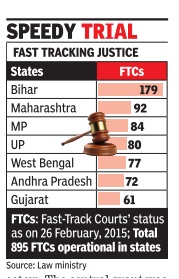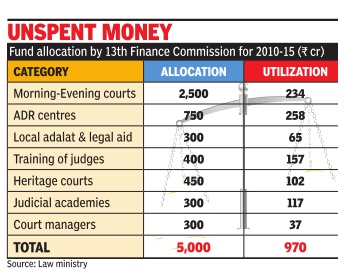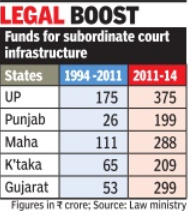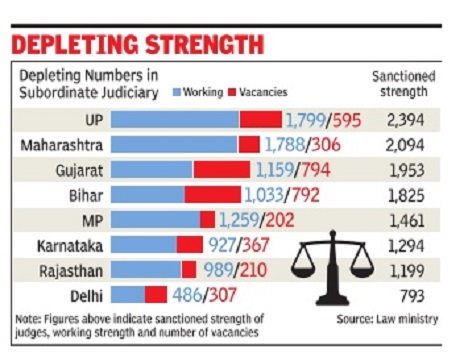Judiciary: India

This is a collection of articles archived for the excellence of their content. Readers will be able to edit existing articles and post new articles directly |
Administrative issues
‘Judges lose 55% court time in administrative work’
Up to 55% of court time is spent by judges each day on tasks such as reissuing summons, fixing dates for future hearings and case administration decisions rather than judicial functions such as hearings, a nationwide survey conducted by Bengaluru-based Daksh has found.
The study analysed over 91,000 court hearings involving over 6,000 cases across the country and argued that even without more manpower, the judiciary can enhance double case disposal rate by delegating “non-substantive” work to court-appointed administrative officers rather than burdening judges.
Data analysed by Daksh showed that an average 87 cases got listed each day before a subordinate court judge and about half were adjourned. “This is far too many, given that a judge sits in an open court for only about five-and-ahalf hours. This means that on average, judges have little more than three-and-a-half minutes on each case,” it said.
‘Give non-substantive work to officers to save time of judges’
This long list of cases before each judge created pressure to hear each case and affected the fundamental objective of a fair hearing, the report said. The study found that in 40% of the 91,797 hearings analysed, other than the date of next hearing, there was absolutely no additional information available on proceedings.
“Of the hearings for which information was available, 47% were adjournments. The reasons for adjournment were varied and attributable to all actors in the system, including the judge, parties to the case, advocates, witnesses and court administrators,” the report said.
“Delegating these functions (issuing summonses and administrative matters) to an administrative officer will give every judge nearly double the time each day for dealing with substantive matters and can significantly improve day-to-day efficiency of courts,” it added.
The study pointed out that case flow management rules notified by most high courts already provided for delegation to an administrative officer. “However, this has not been implemented successfully because the registry in subordinate courts does not have suitable officers who can deal with these issues authoritatively,” the report said.
Daksh offered a solution: appointing retired district judges for a period of two years to deal with procedural matters in the registry. “This will ensure proper procedure of implementing case flow management rules and also help subordinate courts to evolve an efficient longerterm process to deal with administrative matters,” it said.
Administrative procedures
2016: Summonses still hand delivered by process servers
The Times of India, Jun 18 2016
Pradeep Thakur
Judges still use snail mail, blame law
The justice delivery system in India is still moving at a snail's pace. The Supreme Court's e-committee was taken aback when lower court judges from several states told them that they continue to send summonses only through process servers -delivery by hand through baildar (court staff) -and not emails, couriers or even the government's reliable speed post service, as mandated by a 2002 amendment in the Civil Procedure Code. Judges of the subordinate courts expressed their inability to use the modern mode of communication for lack of required amendments in the respective high court rules, which still specify that summonses be delivered only through process servers.
The issue came up for discussion recently at a workshop organised by the e-committee of the apex court on the implementation of the e-courts project across India. The workshop was attended by judges of subordinate courts, registrars of all the high courts and senior law ministry officials, among others.
Senior SC judge Justice Madan B Lokur, the head of the e-committee, reminded the lower court judges and the registrars of the high courts about the 2002 amendment.
A source said, the lower court judges, however, expressed their inability to adopt the modern practices since many high courts had not amended their rules in line with the changes carried out in the CPC. Existing high court rules only permit them to use process servers', the ju nior judges pointed out to Justice Lokur who asked the registrars of the HCs to carry out the required update.
In addition to the use of modern communication tools for delivery of summonses, there is also a move to update litigants, advocates and other stakeholders through SMS and email about the progress of the case and the next date of hearing or the delivery of judgment.
Furthermore, phase-II of the e-courts project also envisages equipping court staff with a hand-held GPS camera enabled PDA -palmtops or personal digital assistants -instruments. At the point of delivery of summonses, the PDA will track time and location of the court officials.This recorded data will simultaneously be available online, reducing the scope of any misgivings that summonses were not delivered.
The government is also in the process of developing a mobile app through which such services will be provided. “It is proposed to prepare mobile phone applications on various mobile operating system platforms to make available information regarding latest judgments delivered by the SC and the high courts, case status, and other information as may be required by lawyers and litigants,“ the ecourt proposal states.
2016: The workload of judges
The Times of India, Apr 07 2016
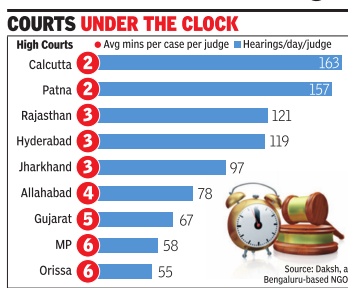
HC judges get just 5-6 min to decide cases, says study
Pradeep Thakur
Mounting cases and shortage of judges are well-documented challenges facing the Indian judiaciary .Now, for the first time, a study has quantitatively analysed the work pressure on judges, and the results are shocking. A judge in a high court spends less than five minutes, on an average, hearing a case, it says.
“The most relaxed high court judges in the country have 15-16 minutes to hear a case, while the busiest have just about 2.5 minutes to hear a case and, on average, they have approximately five-six minutes to decide a case,“ accor ding to the study conducted by Daksh, a Bengaluru-based non-governmental organisation that studies and analy ses judicial performance. For instance, in the Calcutta high court, there are 163 cases listed before a judge on an average day and just over five-andhalf hours are spent hearing cases. The judge, therefore, gets around two minutes over each case.
Similarly , given the very high volume of cases listed before them, judges in the high courts of Patna, Hyderabad, Jharkhand and Rajasthan get two-three minutes on each case per day while in Allahabad, Gujarat, Karnataka, MP and Orissa, they spend 4-6 minutes.
The study has analysed 19 lakh cases and 95 lakh hearings from 21 HCs from January 2015 to the present. Kishore Mandyam, co founder of Daksh, called for a systemic change in court procedures so that a re court procedures so that a realistic number of cases are listed and judges find ample time for hearing and writing well-reasoned judgments.
“Not that judges are not ap plying their mind in writing well-reasoned judgments, but what is the point in listing too many cases and deferring more than half to a next date?“ Mandyam said.
Pruning the list would save precious time and money for the courts besides ending the harassment litigants face waiting endlessly in courtrooms, just to be told that their hearing being rescheduled, he added.
As of April 1, 2016, there are 594 judges in high courts and 25 in the SC, which adds up to 619 judges in the higher judiciary for a population of over 1.25 billion people. Overall, the judge-population ratio in India is way below the desired level. As per the 2011census, there are just 16.8 judges (at all levels) per million population.The apex court, in its judgment of March 21, 2002 in the all India judges association case, had directed that there should be at least 50 judges for every million Indians.
The scale of the problem can be gauged by the fact that it takes, on an average, 1,141 days to dispose of a case in high courts (according to the Daksh study) and 2,184 days in district courts.
E-filing facility only at Bombay, Delhi, MP, Punjab/ Haryana HCs
Nearly a decade after the eCourts project began in 2010 on a mission mode and after having spent close to Rs 1,000 crore, only four high courts in the country have allowed online e-filing of cases. Barring Delhi, Bombay , MP and Punjab & Haryana high courts, online e-filing facility has not been started by other HCs.
According to a statement by minister of state for law P P Chaudhary last week, e-filing of soft copy along with physical copy is being carried out only in the high courts of Delhi, Bombay, Punjab & Haryana and Madhya Pradesh. There are 24 HCs in the country .
Most of the 18,000 functional courts in the country have been computerised, including all subordinate and district courts. Computerisation of courts was initiated by the government in 2010 on a mission mode to be supervised by an apex court e-courts committee to simplify procedures and expedite justice delivery .
The purpose seems to have been defeated with very few courts adopting even the basics of the digitisation features of the proposed eCourts project -e-filing and sending summons through emails being some of them.This despite the fact that one of the prominent reasons for long and repeated adjournments of cases has been summons not being served.
Phase-I of the eCourts project was approved in 2010 with a project cost of Rs 935 crore. At a total expenditure of Rs 639 crore during this phase that en ded in March 2015, about 13,670 dis trict and subordinate courts were computerised. By this time, the Su preme Court and most HCs had completed its digitisa tion process. Phase II of the eCourts project began in July 2015 with the objective of enabling district and sub ordinate courts to adopt digitisation.
The government has allocated Rs 1,670 crore for the second phase and has already released Rs 475 crore, the minister said.
As part of computerisation of co urts, it has been proposed to assess the causes of delay and repeated adjourn ments, making it mandatory for each judge to record the reasons for adjo urnments. In Phase-II of e-Courts, the government had also proposed to in clude audio-video recording of proce edings as that would help discourage retractions by witnesses.
‘Skyping a divorce'
By: Archana More, In a first, Pune court skypes divorce, May 1, 2017: The Times of India
HIGHLIGHTS
A couple sought divorce on online calling facility, Skype in Pune.
The couple had filed their divorce petition by mutual consent under Section 13B of the Hindu Marriage Act, 1955 on August 12, 2016.
For the first time in the history of civil court family matter hearings, a couple sought their divorce on online calling facility, Skype. On Saturday, the applicant husband flew down from Singapore to present his side to the court, while the wife could not come down from London due to personal committments. The Pune court took this opportunity to do something never seen before — they allowed her to present her side on Skype.
The couple had filed their divorce petition by mutual consent under Section 13B of the Hindu Marriage Act, 1955, before VS Malkanpatte-Reddy, civil judge of the senior division, on August 12, 2016.
The petition comprised a narrative of what resulted in the marriage's breakdown. The couple studied at the same college, where they fell in love. Their marriage was solemnised according to Hindu rituals on May 9, 2015, in Amravati. They soon shifted to Pune and began working at two different companies in Hinjewadi. They later purchased a flat in Pimple-Saudagar.
Just a month later, both got an opportunity to work abroad. The husband was selected for a job in Singapore, whereas the wife had to fly to London. While he took the Singapore job, she stayed back. She had said that she really wanted to fly abroad, but that her "marriage was hindering her career". The petition further says that this led to a vast difference of opinion, emphasising their paradoxical natures and ideas of life. They decided to separate and started living apart since June 30, 2015. They filed a petition for divorce by mutual consent in 2016 along with an affidavit from their parents. Advocate Suchit Mundada appeared before court on behalf of both the husband and wife.
After filing their petition for divorce, the wife also moved to London. The terms and conditions of her new job did not let her appear before the court physically for the hearing. So, Mundada filed an application seeking permission to conduct the trial by video conferencing, which the court agreed to. The wife called from London, while the husband was present in court here. Mundada told Pune Mirror, "This the first case in Pune where the divorce decree under Section 13 B has been granted through video conferencing. The court has stated in its order that it has conducted the trial and considered the contentions of the petition along with the respective affidavits. It transpired that the parties have been living separately since June 30, 2015. They have not able to live compassionately and have mutually agreed that their marriage should be dissolved."
Video recording of court trials
Asks HCs To Set Up CCTVs In 2 Dist Courts Of Each State
In an unprecedented step, the Supreme Court directed high courts to install CCTV cameras inside courtrooms in two districts of every state and Union territory within three months to record case proceedings.
“The report of such experiment be submitted within one month of such installation by registrar generals of the respective high courts to the secretary general of the Supreme Court who may have it tabulated and place it before us,“ ordered a bench of Justices A K Goel and U U Lalit.
However, the court said there would not be any audio recording of court proceedings. “We direct that at least two districts in every state UT, CCTV cameras (without audio recording) may be installed inside courts and at such important locations of the court complexes as may be considered appropriate.Monitor thereof may be done in the chamber of the concerned district and sessions judge. Location of district courts and any other issue concerning the subject may be decided by the respective high courts,“ the bench said.
However, the SC barred access of the video footage to lawyers, litigants and general public through the Right to Information (RTI) Act.
“We may make it clear that footage of the CCTV cameras will not be available under the RTI Act and will not be supplied to anyone without the permission of the concerned high court. Instal lation may be completed within three months from today ,“ the bench ordered.
The SC on the administrative side, through a full court meeting chaired by the Chief Justice of India on August 31 last year, had sought to defer the proposal to start a pilot project for video recording of trial court proceedings, saying it had decided to seek further inputs from stakeholders and wider consultations.
The Centre has time and again insisted that the SC take a decision on this. Recently , Union law minister Ravi Shankar Prasad had written to CJI J S Khehar, requesting him to “consider taking up the issue of audio-video recording of co urt proceedings on a pilot basis to start with, at least in some of the district courts“.
The bench of Justices Goel and Lalit had asked additional solicitor general Maninder Singh and senior advocate R Venkatramani on February 6 to act as amicus curiae in a pending petition and visit the Gurgaon district court which had installed CCTV cameras inside and outside court rooms to study the process and present a report to the SC. They found that the CCTVs installed inside Gurgaon courtrooms in 2010 were removed a year later on the order of the high court.
The Centre said in its affidavit that audio-video recording of court proceedings could contribute to transparency of court processes and better case management. The SC bench posted the matter for further hearing on August 9 when it will examine the report on installation of CCTVs in trial courts.
Advice and suggestions of retired judges
Can retired SC judges’ advice be used in courts?
From the archives of The Times of India 2010
Can retired SC judges’ advice be used in courts?
Manoj Mitta | TNN
New Delhi: Opening a new front in the battle for judicial accountability, the Delhi HC has directed the government to take a stand under oath on whether retired Supreme Court judges could give advice to litigants and whether they could also take up arbitration work while they are holding official positions.
A bench comprising acting Chief Justice Madan Lokur and Justice Mukta Gupta asked the Union law ministry on March 10 to file an affidavit on a PIL filed by Delhi-based NGO, Common Cause, alleging that former SC judges were violating the Constitution ‘‘in letter and spirit’’ by tendering legal opinions, which were being produced in various forums of adjudication to influence judgment.
This matter was first taken up last month by the then chief justice of HC, A P Shah, who had just before his retirement asked the government to respond to the PIL. In the subsequent hearing, Justice Lokur came up with the direction for the affidavit as the government had failed to disclose its stand even orally.
Arguing on behalf of Common Cause, advocate Prashant Bhushan said that the lucrative chamber practice among retired SC judges of giving legal opinions was contrary to Article 124(7), which forbids them to ‘‘plead or act in any court or before any authority within the territory of India’’.
In a narrow and self-serving interpretation, former SC judges have construed the expression ‘‘plead or act’’, figuring in Article 124(7), as a bar only on their appearance in courts. The PIL has therefore requested Delhi HC to declare that the act of giving a written advice to be tendered in a court of law also ‘‘comes within the mischief of Article 124(7)’’.
The PIL has also decried the widespread practice among retired judges, both from the SC and the other high courts, to take up arbitration assignments from litigants despite holding constitutional or statutory posts as chairpersons or members of various commissions or tribunals. Though arbitration is encouraged as an alternative dispute resolution (ADR) to expedite high-stake commercial cases, Common Cause pointed out the danger of allowing such private assignments to be given to judges who had already been entrusted with post-retirement tasks of public importance.
Details of some of the payments made to retired Supreme Court judges were obtained by Common Cause from public sector enterprises, which come under the purview of RTI. Former CJI, Justice R C Lahoti, received Rs 3,25,000 from National Thermal Power Corporation Ltd for a legal opinion in 2006-07. He also received Rs 3,25,000 from Rashtriya Ispat Nigam Ltd for a legal opinion during the same period.
In response to an RTI query, the law ministry has stated that there is no written policy in respect of allowing retired SC and HC judges to take up arbitration work while heading a Commission of Inquiry constituted by the Union government and that there are no conditions attached as such to the grant of such permission.
Affirmative action
SC-, ST-, OBC- representation/ 2017-18
Pradeep Thakur , ‘OBCs just 12% of lower court judges’, January 29, 2018: The Times of India
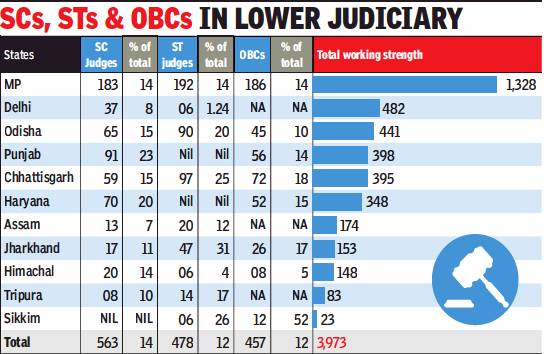
From: Pradeep Thakur , ‘OBCs just 12% of lower court judges’, January 29, 2018: The Times of India
See graphic:
SC-, ST-, OBC- representation in lower judiciary in 2017-18
Data For 11 States Reveals Low Representation
The representation of OBCs or other backward classes in the subordinate judiciary of 11states that responded to the Centre’s request for details adds up to just 12%, considerably lower than the estimates of the community’s share in India’s population.
Data received by the law ministry showed that Dalits comprised less than 14% of judges in the subordinate judiciary, including district courts, and tribals about 12%. The percentage for Dalits was under their share of the population, which stands at 16.6% according to the 2011census. Tribal representation is a little higher than the 8.6% of India’s population they account for.
The degree of representation that Dalits and tribals have achieved in subordinate courts seems to be the result of affirmative action and the less encouraging numbers for the OBCs clearly indicate inadequate recruitment. Without quotas, even if unevenly applied across states, the numbers of SCs/STs would likely plummet.
The information was made available by high courts after the government, last November, wrote to the registrars general of all the 24 HCs requesting data on reservation provided to scheduled castes, scheduled tribes, OBCs and women, and their current working strength.
Not all states have a reservation policy in subordinate judiciary. While some have quotas for state judicial services, which appoint judges in subordinate courts, many don’t have reservation in higher judicial service or district courts. In some states, there is reservation for SCs, STs and OBCs in the higher judicial service but it is a small fraction of the total recruitment.
The representation of Dalits, tribals and OBCs in the report was worked out on the basis of a working strength of about 3,973 judges in 11 states’ subordinate judiciary. The actual working strength may be higher in these states as the entire working strength of district judges has not been accounted for. The data is available for only where reservation is implemented.
Data for some larger states like UP, Bihar and Maharashtra was not available, while that provided by a few others lacked clarity. The findings are significant considering that sections of the political class have been demanding higher representation of women and deprived segments in the judiciary to make it more equitable and representative of the demography.
All India Judicial Service:
Rejected by High Courts
Feb 05 2015
TURF WAR - HCs reject proposal on All-India Judicial Service
The government’s proposal to form an All India Judicial Service for recruitment of judicial officers in the lower courts on the lines of civil services has been rejected by many of the high courts. At an advisory council meeting held by the law ministry recently, law minister Sadanand Gowda informed that “most of the high courts have not favoured the proposal”.
The law ministry had prepared a comprehensive proposal for the All India Judicial Service (AIJS) and the committee of secretaries approved the same in November 2012. Later, at the chief ministers and chief justices conference in April 2013, the higher judiciary sought more time for further deliberations.
The advisory council meeting was held on January 21 with the law minister on the chair. Those who attended included minister of state for home Kiren Rijiju, law commission chairman Justice A P Shah, the attorney general, chairman of the bar council and senior ministry officials.
Unless the high courts and states agree to the constitution of AIJS, the Centre cannot impose the judicial service on states. “The administrative control over the members of subordinate judiciary vests with the HC concerned,” a senior law ministry official said.
Also it is for the state governments to frame rules and regulations, in consultation with the high courts. Already most of the states have framed state judicial services rules governing service conditions of their judicial officers.
It had found favour with the Parliamentary standing committee which in its report in February last year had asked the government to fast track creation of AIJS without any further delay so that the judiciary gets the best talent available.
Supreme Court questions its feasibility: 2017
SC questions feasibility of all-India judicial service, Jan 31, 2017: The Times of India
The Supreme Court questioned the feasibility of the All India Judicial Services on Monday , saying how could the power of high courts to appoint judicial officers in trial courts be taken away .
A bench of Chief Justice J S Khehar and Justice N V Ramana said the high court is a top court of a state and does not work under the control of the SC and the Centre and that it may not be feasible to take away its powers to appoint judges in the state.
“In our federal structure, the HC is the highest court of a state and it is not under the control of Centre or SC.It we go for All India Judicial Services, it may affect the powers of HCs,“ the bench said while hearing a bunch of petitions related to appointment of judges. The petitioners had contended that AIJS should be formed to bring uniformity in the appointment process. The court's observation assumes significance as the Narendra Modi government has recently decided to revive a proposal to constitute an AIJS for appointment of district judges through a rigorous examination process to be conducted by the Union Public Service Commission, similar to the talent hunt for recruitment of officers for the elite civil services. There are at least 4,400 judges' positions vacant in subordinate judiciary , which includes posts of district judges.
The creation of AIJS was first proposed in 1960. The chief justices' conferences held in 1961, 1963 and 1965 had favoured creation of AIJS but the proposal had to be shelved after some states and HCs opposed it, according to a consultation paper prepared in 2001 as part of the National Commission to Review the Working of Constitution.
The government, however, sought dismissal of petitions on judicial reforms, including appointments of judges in HCs and the SC, saying there should not be parallel proceedings when the matter is being dealt in the administrative side. The bench, however, said the matter could not be disposed of all of a sudden as the issue was being examined by the apex court and notice was issued.
Arrest, rules and procedures
Arrest should be avoided if accused cooperates in probe : SC
The Supreme Court has said that custodial interrogation should be avoided if the accused cooperates in the probe, as "a great ignominy, humiliation and disgrace is attached to arrest". "In cases where the court is of the considered view that the accused has joined the investigation and he is fully cooperating with the investigating agency and is not likely to abscond, in that event, custodial interrogation should be avoided. A great ignominy, humiliation and disgrace is attached to arrest. "Arrest leads to many serious consequences not only for the accused but for the entire family and at times for the entire community.
Most people do not make any distinction between arrest at a pre-conviction stage or post-conviction stage," a bench of Justices A K Sikri and R F Nariman said. The bench said while dealing with anticipatory bail plea, the gravity of charge and the exact role of the accused must be properly comprehended and before arrest, the officer must record valid reasons for the arrest in the case diary. It said once the accused is released on anticipatory bail, it would be unreasonable to compel him to surrender before the trial court and again apply for regular bail. The court made the observation while granting anticipatory bail to an accused in a 17-yearold sexual assault case in which rape charge was framed only in 2014. The bench added that "there is no requirement that the accused must make out a 'special case' for exercise of power to grant anticipatory bail". "A person seeking anticipatory bail is still a free man entitled to the presumption of innocence," it said. The court, however, made it clear that "no inflexible guidelines or straitjacket formula can be provided for grant or refusal of anticipatory bail because all circumstances and situations of future cannot be clearly visualised for the grant or refusal of anticipatory bail". The bench said while dealing with anticipatory bail, the nature and gravity of the accusation and the exact role of the accused must be properly comprehended before his arrest. "The possibility of the applicant to flee from justice, the possibility of the accused's likelihood to repeat similar or other offences," must also be considered, it said.
The apex court said that while considering the prayer for grant of anticipatory bail, "a balance has to be struck between two factors, namely, no prejudice should be caused to free, fair and full investigation, and there should be prevention of harassment, humiliation and unjustified detention of the accused." It said that reasonable apprehension of tampering of the witness or apprehension of threat to the complainant should be considered. The bench made the observations while allowing an appeal filed against Gujarat High court's July last year order cancelling anticipatory bail to the accused by a sessions court, noting that the probe was complete and there was no allegation that he may flee the course of justice. "In a matter like this where allegations of rape pertain to the period which is almost 17 years ago and when no charge was framed under section 376 IPC (rape) in the year 2001, and even the prosecutrix did not take any steps for almost 9 years and the charge under section 376 IPC is added only in the year 2014, we see no reason why the appellant should not be given the benefit of anticipatory bail.
Judicial officers' immunity from arrest
From the archives of “The Times of India” :2008
Dhananjay Mahapatra
Judicial officers not immune to arrest
Some years ago, then Chief Justice of India S P Bharucha had said that “80% of judicial officers are honest”. It had invited an immediate “I told you so” reaction from people, abreast with the state of affairs in lower judiciary, who firmed up their view that 20% were corrupt.
Past controversies involving former judges like K Veeraswami, V Ramaswami and Shamit Mukherjee may be rare in judicial history but it would be naive to assume that the cancer of corruption that has weakened the sinews of every sphere of life and governance has not mysteriously touched the judiciary.
Justice B N Agrawal, the senior-most judge of the Supreme Court, remarked during hearing of the Rs 23 crore PF scam that “judges have not descended from heaven but have come from the same society which produces corrupt politicians and corrupt babus”.
Justice Agrawal, held in high esteem by the legal fraternity, later recused himself from hearing the matter being unable to stomach provocative arguments advanced by former law minister and senior advocate Shanti Bhushan and his advocate son Prashant Bhushan, who wanted registration of FIRs against judicial officers accused of committing a crime.
The spat was unnecessary, more so because a three-judge SC Bench, nearly two decades back in the Delhi Judicial Service Association vs State of Gujarat [1991 SCC (4) 406] case, had unanimously held that a judicial officer facing criminal charges could most certainly be probed and even arrested.
The case related to police excesses on a chief judicial magistrate, who had angered police by stricturing them every now and then for not cooperating with the courts for effecting summons, warrants and notices. The Nadiad police had brought the CJM to the police station, tied him with ropes, forced him to drink liquor, handcuffed him and called press photographers to take snaps of an inebriated CJM, that was front paged in many local dailies. An independent inquiry followed and the policemen were taken to task by the Supreme Court.
The assault on an honest “no nonsense” judicial officer made the SC wake up to the urgent need to protect lower court judges, who could otherwise face false cases the moment they rubbed the police and administration the wrong way. The court, except for giving some allowances to protect the independence of judiciary, made no attempt to distinguish a judicial officer from a common man, when both of them were on the wrong side of the law.
“No person, whatever his rank or designation may be, is above law and he must face the penal consequences of infraction of criminal law. A magistrate, judge or any other judicial officer is liable to criminal prosecution for an offence like any other citizen,” it said.
Having said this, the apex court did not feel comfortable in making judges, who are empowered to scrutinise the investigations by police in various cases, whipping boys at the hands of the law enforcers.
To find a balance between independence of judiciary and probing a judge accused of breaching law, it laid down comprehensive guidelines. The main points were:
A judicial officer can be arrested for an offence under intimation to the district judge or the high court.
If immediate arrest of a judicial officer of the subordinate judiciary is necessary, a technical or formal arrest may be effected. Arrest should be immediately communicated to the district judge and Chief Justice of high court
Arrested judicial officer will not be taken to police station without prior directions from the district judge
There should be no handcuffing of the arrested judicial officer. But if he turns violent, and there is a danger to life and limb, he can be handcuffed with intimation to district judge as well as to the CJ of the HC concerned
If the handcuffing and arrest are found to be unjustified, the police officers concerned will be suitably penalised by the HC concerned
These guidelines were again discussed by a five-judge constitution Bench, which on August 14, 2002, unanimously approved them saying these were “sufficient to protect the independence of judicial officers”.
As the law laid down by the apex court does not bar the police from investigating judges of the subordinate judiciary, the sound and fury shown by the eminent and experienced lawyers before a Bench headed by Justice Agrawal on Thursday was unnecessary, to say the least. Wish, they had bothered to present their arguments based on the 1991 judgment!
It is another matter that two months prior to the laying down of guidelines, a five-judge constitution Bench of the Supreme Court in K Veeraswami case [1991 SCC (3) 655] had ruled that though the judges of HCs and the SC were public servants, they could not be proceeded against unless the President accorded sanction after a mandatory consultation with the CJI.
Complaints against the judiciary
2017: Nature of complaints: mainly about delays
Pradeep Thakur, `Judiciary needs body to redress grievances', April 29, 2017: The Times of India
50% Plaints Against Delay In Proceedings
The government is inundated with complaints against the judiciary with the department of justice in the Union law ministry getting into the list of top 20 ministries and departments which receive maximum complaints -from an average 10,000 to 12,000 a year, the number of complaints have gone up to nearly 14,000 last year.
An analysis made by the government of the nature of these complaints has revealed that almost 50% of them are against delay in delivery of judgements, 15% are about alleged corruption in the judiciary and 10% relate to unfair judgements. Unlike other departments, grievance redressal mechanisms are almost non-existent in case of the judiciary . At a recent regional level meeting held with the judiciary, the government expressed concern over this lacunae. It has been suggested that the high courts and the Supreme Court can have a dedicated grievance redressal portal where action taken reports can be uploaded.
At present, all the grievances received are hardly resolved or settled even after they are forwarded to the secretary general of the SC and registrar general of the HCs concerned, sources said. As per the norm, the SC looks into the complaints against the higher judiciary while the HCs are responsible for settlement of all complaints against the district and subordinate judiciary .
The government has suggested that the HCs create a public grievance portal like the one created by the National Legal Service Authority and upload the reply with a copy endorsed to the depart ment of justice. It has also been suggested that grievances received in high courts can be periodically reviewed by the nodal officer who can submit before the committee of judges or the chief justice the grievances which need some action to be taken others can be responded to by him and an action taken report filed. A majority of the complaints received are related to the lower judiciary, at the district and taluka level courts.
Corruption
2019/ Madras HC: Yes, there is corruption in the judiciary
In a rare admission, the Madras high court has said even the judiciary is not exempt from the clutches of corruption and that corrupt judicial officers and public servants should be declared anti-nationals.
Justice SM Subramaniam, in scathing remarks on Thursday, observed that corruption in the judiciary was the greatest enemy of the Constitution and that the judiciary must also initiate drastic measures to control corruption in various forms. Noting that bribing public authorities starts right from the child in the mother's womb, the judge said officials had to be bribed even for getting the benefits of government welfare schemes.
"They are anti-nationals because they are obstructing the development of this great nation. Terrorists are declared as anti-social elements. Thus, persons corrupt and acting against the developmental activities of our nation are also to be declared as anti-nationals. These anti-nationals do not care about the development of this country but are only interested in their self-development," Justice Subramaniam said.
"It is painful and unfortunate to state that sexual favours are demanded in lieu of bribe in educational institutions and public offices and what else can be worse than this in public administration," Justice Subramaniam said.
The worst form of corruption was happening at burial grounds and we people tolerate even that. Unless public servants at burial grounds maintained by the state or local bodies are bribed, the dead body will not get an appropriate timing for burial. The right to decent burial is also denied, the judge added.
Coming down heavily on poll-related corruption, the judge said, "these representatives of the people are not only accountable but also responsible for enactment of laws. If they indulge in such corrupt activities like bribing voters, the very foundation of democratic principles is shaken."
The court made the observations while dismissing a plea moved by P Saravanan, a village administrative officer (VAO), who was suspended from service on allegations of corruption. Saravanan wanted the court to quash his suspension and direct the authorities to reinstate him in service.
Data of cases
2018: Status of uploading by lower courts
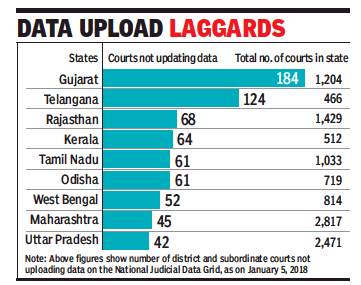
It also shows how many of these courts had not uploaded case data
From: Pradeep Thakur, 1,000 lower courts not updating case data on nat’l grid, January 25, 2018: The Times of India
See graphic:
This Jan 2018 graphic gives the number of courts in some of the bigger states,
It also shows how many of these courts had not uploaded case data.
As part of its exercise to monitor performance of subordinate judiciary, the government has analysed the data uploaded on the national judicial data grid (NJDG) and found that many subordinate courts across the country aren’t updating daily progress of cases on the website. At least 1,000 district and subordinate courts aren’t updating data regularly although this analyses is also crucial to monitoring the performance of judges of the lower courts.
In order to bring transparency in judicial functions and reduce pendency, the government with the help of the Supreme Court had started online portal NJDG a few years ago, making it mandatory for all subordinate and district courts to upload daily case status on it. The NJDG gives daily status report of each court on cases filed, disposed of, under objection and status of those pending for more than two years, five years or 10 years. The NJDG also has details of cases filed by women and senior citizens in respect of each of these courts and the progress of proceedings on a daily basis.
However, a analysis by the government found that many of these courts in several states have not been updating data.
Leading the list of defaulters is Gujarat where 184 district and subordinate courts have not been filing the required data on the NJDG as on January 5, 2018, according to the analyses prepared by a team at the law ministry. About 84 of these courts have not updated their records for more than a month when it is mandatory to upload status reports on a daily basis.
As part of its ongoing implementation of the second phase of e-courts project, monitored by the SC ecommittee, the government has started giving unique IDs to all judges-—more than 16,000 in the subordinate judiciary and 650 in the higher judiciary.
Judges with unique IDs will have to specify the nature of proceedings on a daily basis in the online log sheet, whether he delivered judgment, reserved it or no business was transacted. In the new software CIS 2.0, the judge will have to mention reasons if no business was transacted. Such details specific to a judge would help the higher judiciary in considering promotion and elevation of the lower court judges to the higher judiciary. At present it is difficult to track past performances of a judge once he or she is transferred to a different court.
District judges, the selection of
From the archives of The Times of India 2010
Dist judges’ merit quota down 15%
Most Posts To Be Filled On Seniority
Dhananjay Mahapatra | TNN
New Delhi: The merit-based selection window to fill posts of district judges, who are key to the functioning and efficiency of the lower judiciary, will shrink by a huge 15% margin from 2011, the Supreme Court ordered on Tuesday. The large number of vacancies in the posts of district judges, who head the functioning of subordinate courts in the concerned district subordinate judiciary, weighed on the mind of the apex court and it ordered that the merit quota be reduced from 25% to 10% from January 1, 2011.
In 2002, the SC had ordered that of the total vacancies in district judges posts, 50% would be filled by senioritycum-merit from among the senior civil judges while another 25% would be filled by a limited departmental competitive examination to fasttrack promotion for the meritorious among senior civil judges. The rest 25% were filled through direct recruitment from the Bar.
But, the large number of vacancies — in some states more than 50 accumulated over the years under the 25% competition examination quota —made a Bench comprising Chief Justice K G Balakrishnan and Justices Deepak Verma and B S Chauhan to wear their thinking caps. On one hand, amicus curiae and senior advocate Vijay Hansaria reeled out statistics about the large number of vacancies in the posts of district judges and the mounting pendency of cases, while on the other major high courts — Bombay, Gujarat, Madhya Pradesh, Rajasthan and Orissa — opposed any reduction in the 25% merit-quota in recruitment.
Even those states where the HCs were opposed to reduction in the merit quota, there were a large number of vacancies in district judges posts. However, the court did not interfere with the ongoing process for selection of district judges under the 25% quota. But, what it ordered was that from January 2011, the quota would be reduced from 25% to 10% and if still posts remained vacant, they would be filled through regular promotions.
This means, the quota for selecting district judges through regular promotion would now swell from 50% to 65% of the total vacancy.
Executive vs Judiciary
2016
Sudhir Krishnaswamy , The People’s Court “India Today” 5/12/2016
On November 18, 2016, a Supreme Court collegium comprising four senior judges (the fifth, Justice J. Chelameswar, refused to attend in person) returned the names of 43 judges for appointment to various high courts to the Union executive after reconsideration. Under the applicable procedural rules, the Union executive is now bound to appoint these judges. This sets the stage for a direct confrontation between the executive - which seeks to exploit every procedural wrinkle to impose its will on the appointment process - and a judiciary which has failed to reform this opaque and unaccountable process. This clash of institutions has produced a constitutional crisis not seen since Indira Gandhi's attempts to mould the judiciary in her own image. But it's not too late for the judiciary to craft a new approach to appointments that buttresses its popular legitimacy and avoids a dangerous loss of autonomy. It all started in October 2015 when an SC bench struck down the 99th constitutional amendment and supplementary legislation that sought to establish a new method of appointing higher court judges through a National Judicial Appointments Commission (NJAC). Having wrested back control, Justice J.S. Khehar, in a spirit of statesmanship, invited the Union executive to draft a new memorandum of procedure to regulate executive-judicial interaction in the appointment process. This olive branch could have paved the way for genuine institutional reform of the collegium process with greater transparency and executive/public participation. Instead, a year later the memorandum is yet to be approved and the cold exchanges between the executive and judiciary are shrouded in secrecy. In this period, the Union executive has stalled appointments to the higher courts (a list of 77 has been pending for over nine months). Earlier this month, the executive cleared 34 judges after much public wrangling. Significantly, all 34 were from the subordinate judiciary who, on current evidence, decide fewer cases and are less likely to strike down legislative/executive action than advocates appointed from the HC bar.
Union law minister Ravi Shankar Prasad has counselled the executive and the court to overcome their differences, to promote comity. This is doubly wrong advice: wrong on facts and wrong on principle. Firstly, since May 2014, the new majority executive government has sought to overcome the SC's adjudication whenever it's inconvenient. Led by a belligerent attorney general, it has pushed to reconstitute benches, ostensibly to allow for larger ones to overrule binding precedent. This disrupts existing benches and postpones potentially adverse judicial outcomes. Where the courts decided against the Union, as with the proclamations of emergencies in Arunachal Pradesh, the majority party has undermined court decisions by achieving through political means what is forbidden by constitutional means.
Secondly, this advice misunderstands the principled justification for a Supreme Court in a constitutional democracy. As Montesquieu reminds us in Book 11 of The Spirit of Laws, political liberty is to be found only where there is 'moderate government'. Moderate governments are produced not by choosing virtuous leaders, but by ensuring that 'power should be a check to power'. This teaching is inscribed into the Indian Constitution which divides power between the various branches of government. For India to remain a constitutional democracy, we need a Supreme Court that operates as an effective check on majoritarian legislative and executive power. The executive will make the next move in this strategic institutional game when it decides on the 43 names before it. Irrespective of the results in this round of the battle, the SC needs to evolve a grand strategy that preserves its institutional autonomy and non-partisan character. A successful strategy would be to transform this two-way conversation between executive and judiciary into a three-way conversation by bringing the people back in. The court should mobilise its high popular social and political legitimacy to speak directly to the people over the heads of the legislature and the executive. The court failed to grasp this opportunity last year when, through a new order clarifying the application of the NJAC decision, it crafted its orders striking down the NJAC laws. Circumstances have provided it with another opportunity to secure India's constitutional democracy which hinges on an autonomous and non-partisan judiciary. This time the court must reshape the collegium process by adopting a protocol of transparency and openness in judicial appointment and incorporate two independent non-political persons in the collegium process. Such a move would delegitimise executive and legislative overreach and revitalise India's constitutional democracy for the 21st century.
The author is Director, School of Policy and Governance, Azim Premji University
Fast-Track Courts
Bihar tops in justice delivery with 179 fast-track courts
TIMES NEWS NETWORK The Times of India Mar 04 2015
Bihar continues to operate the highest number of fast-track courts in the country , with 179 of them functional as of last month. Maharashtra, Madhya Pradesh, UP, Bengal, Andhra Pradesh and Gujarat are others with high number of such courts. The Centre plans to encourage setting up of at least 1,800 fast-track courts (FTCs) to deal with cases of heinous crimes, cases involving senior citizens, women, children, disabled and disputes involving land acquisition and property pending for more than five years.
Besides, the government has also proposed setting up 460 family courts in the next five years in districts with a population of one million or more, where these courts are not already present. The funding of these projects will come through the 14th Finance Commission awards.
Earlier, in 2000, the central government had allocated financial resources to the states for setting up fast-track courts when 1,734 FTCs were set up. The central grant was made available for a fixed time period of five years but was extended till 2011. Some of the states such as Bihar, Himachal and Maharashtra have continued FTCs with their own resources.
However, during a recent meeting of the advisory council of the National Mission for Justice Delivery and Legal Reforms, chaired by law minister Sadananda Gowda in January, an opinion was expressed against encouraging FTCs. A view was expressed that fast tracking certain categories of cases results in slow tracking other categories.Law commission chairman Justice A P Shah had suggested that a more holistic approach be adopted for pendency reduction.
After the Nirbhaya gangrape incident of December 2012 in Delhi, the law ministry had decided to provide funds up to Rs 80 crore per annum on a matching basis from states till March 2015.However, the Centre specified that this grant money will be used only for the purpose of meeting salaries of judges required for running these FTCs.
After the Delhi incident, states and chief justices had resolved to set up additional FTCs relating to offences against women, children differently abled persons and senior citizens and marginalized sections of society.
According to a status report of the law ministry , 212 FTCs have been set up so far for the purpose of fast tracking cases against women and children in 16 states.
Fast track courts: 2000, 2015
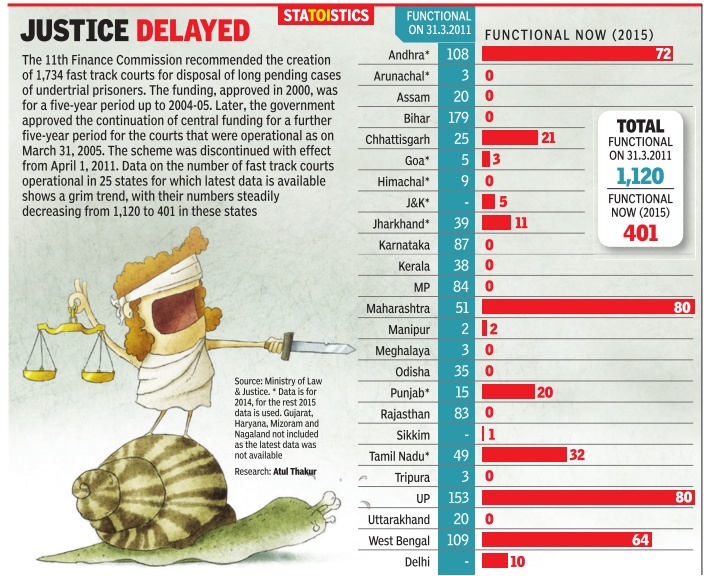
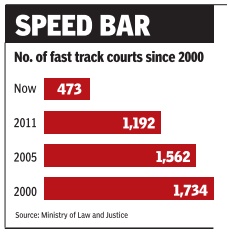
Central funds allocated, 2015-20
See graphic.
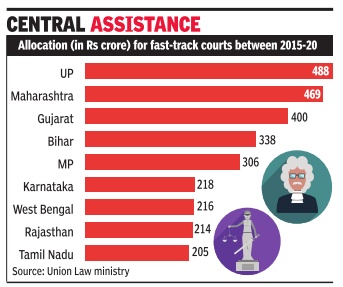
Guidance from SC to HCs
Don’t protect accused from arrest without quashing FIR
Court Objects To Telengana Court Order
Giving a lesson to courts in administering the criminal justice system, the Supreme Court has ruled that no high court should protect an accused from arrest while rejecting his petition for quashing of the First Information Report (FIR).
A bench of Justices Dipak Misra and Amitava Roy took serious objection to an order passed by the Telengana high court, which ordered police not to arrest Habib Abdullah Jeelani, even while rejecting his plea, for quashing of the criminal case arising from assaulting a person with dangerous weapons.
Writing the judgement for the bench, Justice Misra said: “It is absolutely inconceivable and unthinkable to pass an order of the present nature while declining to interfere or expressing opinion that it is not appropriate to stay the investigation.This kind of order is really inappropriate and unseemly. It has no sanction in law.“
The Supreme Court said: “The courts should oust and obstruct unscrupulous litigants from invoking the inherent jurisdiction of the court on the drop of a hat to file an application for quashing of launching an FIR or investigation and then seek relief by an interim order. It is the obligation of the court to keep such unprincipled and unethical litigants at bay .“
Justices Misra and Roy took note of certain orders passed by high courts asking the trial courts to grant bail to the accused once he had surrendered. The bench said such orders neither have the sanction of law nor conceivable in the light of law declared by the apex court.
Referring to a host of judgements of the apex court deprecating such orders passed by high courts in the past, the bench said: “It is intellectual truancy to avoid precedents and issue directions which are not in consonance with law. It is the duty of a judge to sustain the judicial balance and not to think of an order which can cause trauma to the process of adjudication.“
“It should be borne in mind that the culture of adjudication is stabilised when intellectual discipline is maintained and further when such discipline constantly keeps guard on mind,“ the bench said advising the high courts not to go beyond the law and decisions of the apex court.
The court set aside the Telengana high court's decision and directed that police should proceed with the investigation into the criminal case in accordance with law.
Set up centres under all High Courts for vulnerable victims: SC
Krishnadas Rajagopal, October 30, 2017: The Hindu
At least two special deposition centres must be set up within 3 months
Vulnerable witnesses in criminal cases, often minor survivors of rape or victims of sex abuse, should testify without fear or intimidation in a conducive environment, the Supreme Court has said.
Concerned at the trauma these victims of crime face in conventional courtrooms, the Supreme Court has ordered the setting up of at least two vulnerable witnesses deposition centres in the jurisdiction of every High Court across the country within the next three months. The order upholds the right of vulnerable witnesses to be protected while testifying in court and is in consonance with international norms in these matters.
A Bench of Justices A.K. Goel and U.U. Lalit found that vulnerable witnesses are often treated like any other witness of the State in a criminal trial. Victims often end up being ill-treated by the very system they had approached in the hope of justice. Delay and intimidating questions during trial in a hostile environment lead to fewer convictions.
Friendly atmosphere
Setting aside the acquittal by the high court of a child rapist, the Bench acknowledged the arguments for more vulnerable witness deposition complexes across the country made by its amicus in the case, advocate Shirin Khajuria. “There should be special centres for examination of vulnerable witnesses in criminal cases in the interest of conducive environment in court so as to encourage a vulnerable victim to make a statement,” the Bench noted in its order.
The Bench said eventually every district should have a special centre, which would provide vulnerable witnesses a friendly atmosphere to testify. The Supreme Court referred to the Delhi High Court’s initiative to set up vulnerable witnesses deposition centres and issuance of guidelines.
‘Adopt guidelines’ given in Sakshi v. Union of India and Ors.
The Bench suggested that other high courts should adopt the Delhi HC’s ‘Guidelines for Recording the Evidence of Vulnerable Witnesses in Criminal Matters,’ with required modifications. The Delhi HC’s guidelines are filtered from the best practices followed by other countries and the police and precedents of the apex court and high courts.
The practices include a screen or some arrangement by which the victim does not see the body or face of the accused; reducing cross-examination questions to writing and handing them over to the judge to be put to the victim in a language that is clear and not embarrassing; and sufficient breaks for victims of child abuse or rape while testifying.
The Bench recommended that the high courts trigger the initiative with at least two centres in the next three months. But they must not stop with that and continue to set up more such centres.
SC: Higher courts can’t compel lower courts to pass orders
The Supreme Court has held that independence of lower courts cannot be tinkered with by higher courts and no superior court in hierarchical jurisdiction can direct any subordinate court to pass a particular order.
A bench of Justices R K Agrawal and Abhay Manohar Sapre took strong exception toorder passedby Rajasthan HCdirecting a trial court to grant bailtotwo accusedin a criminal case. The court said that the HC judge had passed the order without “applying his mind” and quashed it saying that it was against judicial discipline and amountedtointerfering in the proceeding of lower court.
“Nosuperior court in hierarchical jurisdiction can issue such direction/mandamusto any subordinatecourt commanding them to pass a particular order on any application filed by any party. The judicial independence of every court in passing the orders in cases is well settled. It cannot be interfered with by any court including superior court,” thebenchsaid.
The bench said it was the sole discretion of lower court to find out after hearing the bail application as to whether case was made out for grant of bailor not. Itsaid the sessions judge, who was to hear the bail plea, had to apply his independent judicial mind and accordingly pass appropriate reasoned order keeping in view the facts involved in the case and the HC had no jurisdiction to direct it to grant bail.
“In our considered opinion, the HC had no jurisdiction todirectthesessions judge to allow the application for grant of bail. Indeed, once such direction had been issued by HC then what was left for the sessions judge to decide except to follow the directions of HC and grant bail. In other words, in compliance to the mandatory directions issued by HC, the sessions judge had no jurisdiction to rejectthebail application but to allow it,” thebenchsaid.
“When an order is passed, itcan be questionedby the aggrieved party in appeal or revision, as the case may be, to the superior court. It is then for the appellate/revisionary court to decide as to what orders needtobe passedin exercise of its appellate/revisionery jurisdiction. Even while remanding the case to the subordinate court, the superior court cannot issue a direction tothe subordinate court to either “allow” the case or “reject” it. If any such directions are issued, it would amount to usurping the powers of that court and would amount to interfering in the discretionary powers of the subordinate court. Such order is, therefore, not legally sustainable,” itsaid.
In this case the sessions judge had summoned two people by issuing non-bailable warrant against them on a plea of a complainant seeking its direction to make them accused in a kidnapping case as the police had not filed chargesheet against them despite sufficient evidence againstthem.
The accused then challenged the order of the lower court in HC which directed them to immediately surrender before the trial court and also ordered the lower court to grant them bail on the same day. Aggrieved by the HC order, the complainant moved SC which set aside the HC order. The court noted that HC passed the order withouthearing the view of police and thecomplainant.
“In our considered opinion, the single judge (of HC) seemed to have passed the impugned order without application of judicial mind in as much as he committed two glaring errors while passing theorder. First, hefailed toseethat thecomplainant at whose instance the sessions judge had passed the order and had allowed his application was a necessary party to the criminal revision along with the State. Therefore, he should have been impleaded as respondent along with the State in the revision,” the bench said.
Lawyers intimidate judges
The rise of intimidating arguments
Among democracy's pillars--legislature, execu tive and judiciary--the third pillar is most vulnerable to canards spread against its members and least equipped to fight it.
Parliament and assemblies can debate charges of corruption against their members, with the concerned members participating and giving their defence. A government and members of the executive can take recourse to defamation laws to fight unfounded allegations.
A judge is a sitting duck for canards whispered in court corridors. The feared contempt of court shield seldom gets activated when unfounded corruption allegations are spread by lawyers.
In the last two decades, this disturbing trend has steadily picked up pace. This trend has an umbilical link with the mind boggling fees charged by lawyers. Anyone paying more than a million rupees to a top lawyer, surrounded by a bunch of well-heeled juniors, for a 10minute argument on his behalf in the Supreme Court would expect nothing but a favourable verdict.
When arguments last for many days and fees get multiplied, the expectation soars that much higher. And, in high-stake litigations, warring parties pay even more heavily in terms of lawyers' fees.The lawyers who charge such a fortune keep assuring their clients of certain victory .
Unfortunately , in litigation, both parties seldom win.How does a lawyer console a defeated and financially deflated client? The easy way is to accuse the judge of corruption without the fear of being confronted by the judge. We have witnessed and heard lawyers of losing sides coming out of the court and nonchalantly telling the client, “I think the other side struck a deal with the judge.“ This could be true in some cases.
But it is the routine regularity of such allegations which we are discussing without de nying the existence of black sheep among judges. The debate is also not meant to brush under the carpet the ugly head of corruption making inroads into judiciary .
But when reputed lawyers, or their juniors, spread canards about judges, it causes immense damage to the justice delivery system institution, its credibility and its independence.
Canards always get headwind in an era of suspicion, like the one we are living in. No one needs proof. Word of mouth is enough to tarnish an individual's reputation, more so of a judge since, traditionally , he is expected to possess an impeccable character laced with uncompromising integrity. No one puts the character of the lawyer who makes the unfounded allegations under scrutiny . Criticising a judgment is a fair practice. Logical criticism often educates a judge as he grows in judiciary . But when the court corridors get infected with diatribes against judges born out of suspicion, it casts an unmitigable shadow on the judiciary's ability to dispense justice.
This corrodes public faith in the fairness of courts.When public faith in judiciary gets wobbly , every judge comes under pressure not to deliver an unpopular verdict. Such constriction of judicial mind is nothing but an incursion of judicial independence. How does judiciary extricaitself from such canards by te itself from such canards by lawyers, who are expected to be equal partners in justice dispensation? This is increasingly making judges attempt the impossible to deliver a judgment that is not only legally and ethically correct but also does not offend popular belief.
Anxiety among judges to be popularly correct is mainly caused by a section of activist lawyers, who have made significant contributions in exposing corruption in high places.Taking recourse to public interest litigation, they fought against the high and mighty among people's representatives who distributed valuable natural resources as largesse for bribes. They rightly became heroes in civil society.
Remember what Lord John Acton had said in 1887 power tends to corrupt and absolute power corrupts absolutely. Fame and popularity too have similar failings. It is a challenging task to remain an ordinary person when one gets fame and popularity by being hailed as the David for scripting unlikely victory against the Goliath.
Amid unimaginable fame and popularity , some activist lawyers, given their track record of successfully taking on the unscrupulous among the rich and powerful, are forced to think they have developed a halo of truth in whatever they allege. Judges mostly entertain their petitions against corruption. But there are times when a judge questions the quality of evidence attached to their petitions. The judge's questions are generally met with the answer, “I have gone through the material and I am convinced about the truth in the allegations.“ Despite the self-certifica tion, if a judge dares to dismiss the petition, then canard mills get activated instantaneously .In some cases, a judge's questionable integrity being the cause behind dismissal of a petition against corruption might have some truth. But to employ such tactics in every failed case filed by an activist lawyer would render the bravest of the brave judges defensive.
We do not know how this trend is to be remedied. But it reminds one of a famous saying, “Whoever undertakes to set himself as a judge of truth and knowledge is shipwrecked by the laughter of gods.“
Modernisation of court infrastructure
2019/ Delhi’s Rouse Avenue Court Complex
Aamir Khan2, Courtroom like never before? Judge for yourself, April 10, 2019: The Times of India
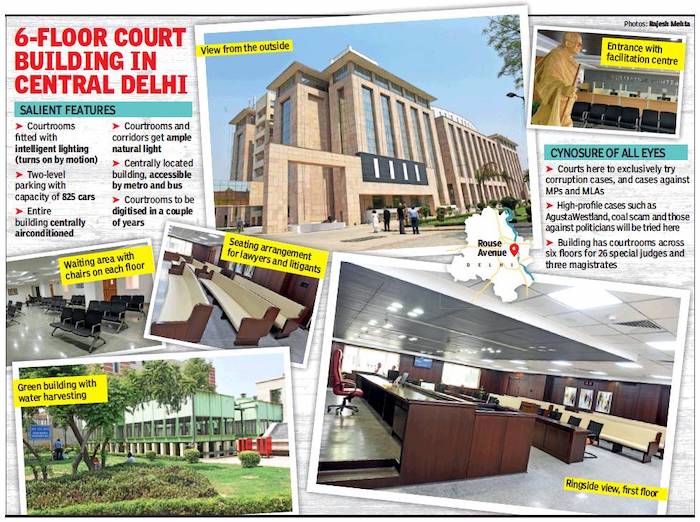
From: Aamir Khan2, Courtroom like never before? Judge for yourself, April 10, 2019: The Times of India
ROUSE AVENUE FACILITY OPENS: State-Of-The-Art Complex Has Many Firsts To Its Name; High-Profile Cases To Be Tried
Intelligent lighting with motion sensors, ample sitting space in a modern ambience for litigants and smartly designed sofas in courtrooms. Who would think this is how a courtroom looks? The image of a legal proceeding in India has always been of a slumberous trial room, a fan lazily turning over a predominantly oldworld room equipped with straight-back wooden furniture that showed some signs of life only when the judge announced, almost perfunctorily, the date of the next hearing. This stereotype just does not fit into the modern infrastructure at the Rouse Avenue Court Complex.
During the opening ceremony on Monday, Rajendra Menon, chief justice of Delhi high court, remarked that the building was set to start operations only four years after its completion. The Rouse Avenue complex houses courts of 26 special judges for CBI cases and three magisterial courts, including one for cases pertaining to MPs and MLAs. On Tuesday, when judicial operations started, litigants and lawyers did not show up in great numbers owing to the limited cases scheduled for hearing.
But for those who were there, it was a new experience from, say, the crowded Patiala House Courts, where the courtrooms do not even have adequate space for court records, as a court officer pointed out. He was happy to have a spacious record room with advanced technology. The modern looks and the cleanliness are a bonus.
The courtrooms showcase sophisticated wooden furniture, motion sensor lighting and striking sofas. The lighting technology is the first to be incorporated in any of the trial court complexes in the capital’s 11 districts. Extended corridors and courtrooms situated on each floor are well lit-up with abundant natural light, which refract through the tall glass windows. Architect Goonmeet Singh Chauhan, who designed the complex, said the complex strive for minimal use of electricity and called it a “four starrated green building”.
Special treatment has been given to the aesthetics of the courtrooms and corridors. Framed pictures of Indian birds adorn the walls, while the main entrance is enlivened by a little-bigger-than-life-size statue of Mahatma Gandhi. The convenience and comfort of litigants too is a priority. Outside each courtroom, sufficient space has been set aside for a waiting area, where they can sit in centrally air-conditioned comfort, away from the scorching sun in summers.
However, Advocate Pramod Kumar Dubey, who had come to represent a client in a corruption case, felt that given the nature of all CBI cases, the space allocated was actually inadequate. "Often, due to the charge in a CBI case being a conspiracy in corruption cases, there are a number of accused so the courtrooms need to have sufficient space to accommodate the accused as well as their counsels,” he said.
In using modern technology to create an eco-friendly, self-sufficient environment, the architect did not neglect safety. There are several fire exits to cope with all sorts of emergencies. A separate passageway has been created for the movement of the judges within the court premises.
Green spaces, with grass patches and flower pots, greet visitors inside the building. Outside is a garden that is equipped for the modern age with a rainwater harvesting system. According to architect Singh, effluent is recycled and the water used for the airconditioning and for the garden. The staircase and lift lobbies start from the second-level basement. The two basement parking can hold 825 cars at a time, a capacity that is higher than at most of the court complexes in the city.
Special judge O P Saini, tasked with exclusively handling the 2G scam trial, is administrative head of the new facility. Each district from where the CBI courts have been transferred has been allocated a floor.
Recusal of judges
Feb 23, 2015
Seeking recusal of judges now a trend in high-profile cases
Dhananjay Mahapatra
Stepping into the Supreme Court premises for the first time as a student of law was an exhilarating experience. It literally gave goosebumps. We had read landmark judgments given by this great institution which kept ‘rule of law’ and ‘equality’ secure in the stormiest periods. Covering the Supreme Court on a day-to-day basis for the last two decades has been no less exhilarating. The court always gives a distinct impression that it strictly adheres, or as far as possible, to the maxim: “be you ever so high, the law is above you”.
These immortal words by 17th century English churchman and historian Thomas Fuller read, “Be ye ever so high, still the law is above you.” Celebrated English judge Lord Alfred Thompson Denning, in the case Goriet vs Union of Postal Workers, modified the maxim a bit in 1977 and wrote, “Be you ever so high, the law is above you.” In the last 38 years, Supreme Court judges have used it in umpteen number of cases where the high and mighty attempted to dodge the long arm of the law by hiring top legal brains.
There have been several examples in the last two decades where the court remained unfazed by the tactics of litigants and accused to overawe the court and seek recusal of judges by alleging bias against them. The intention was to see an “uncomfortable” judge recuse from hearing their case.
The Sohrabuddin Sheikh fake encounter case is one such. It was being heard by a bench headed by Justice Aftab Alam. Then Gujarat minister Amit Shah was granted bail but asked to stay out of the state to allow a fair probe. Later on, there were pleas for cancellation of Shah's bail. His counsel Ram Jethmalani argued “bias“ on Justice Alam's part. It was unprecedented to find a counsel as famous, respected and knowl edgeable as Jethmalani telling a telling a judge bluntly that it would be better if he recused from the hearing.
It embarrassed the judge.But Justice Alam kept his cool and adhered to the “you be ever so high, the law is above you“ principle and decided the pleas.
Sahara chief Subrata Roy was sent to jail on March 4 last year for continuously violating SC orders directing two group companies to refund Rs 24,000 crore with interest to three crore investors through market regulator Sebi. True, the court found that the mon ey was raised through onetime fully convertible debentures in a suspicious manner. But there was hardly any complaint from investors against the Sahara group companies.
Roy had hired top legal brains. One of them, Rajeev Dhavan, argued bias against a bench of Justices S Radhakrishnan and J S Khehar and used Jethmalani's `blunt' method to seek their recusal from the case.
Justice Khehar demolished the arguments of bias and said it was a handle used by senior advocates to browbeat the judges. The bench rendered a judgment, but the ‘bias’ argument left it very anguished. The judges knew it was a ‘bench-hunting’ tactic.
Yet, they decided to recuse from the case.
In both these cases, bias was attributed directly to the judges in open court. Yet, the CJIs felt that rule of law did not warrant shifting the case to another bench.
The trend was somewhat clouded by the recent decision of the CJI who changed the bench that first heard the anticipatory bail plea of social activist Teesta Setalvad and her husband Javed Anand, who were accused of misusing donations received for welfare of riot victims.
A bench of Justices S J Mukhopadhaya and N V Ramana heard the pleas for close to half-an-hour. It did ask some uncomfortable questions but allowed Setalvad’s counsel to file additional documents.
The bench stayed her arrest for six days and promised that there would be justice.
The uncomfortable questions appeared to have unnerved advocates who were present in large numbers in the court room to express solidarity with the human rights activist. Immediately after the case was adjourned, a focused campaign was unleashed.
It portrayed an apprehension that the judges could possibly be biased against Setalvad because PM Narendra Modi had attended the wedding of their children. And who does not know the bitter tussle between Setalvad and the then Gujarat government headed by Modi.
Extending the same rule, would the campaign be not termed biased? Were the advocates behind the campaign not very friendly with Setalvad? Well, no one can dare ask such questions to human rights activists.
A new bench of Justices Dipak Misra and Adarsh Goel further extended the stay on the couple’s arrest and promised them anticipatory bail.
Given the nature of the case against Setalvad, the decision is correct. But this could also have been the decision of the bench of Justices Mukhopadhaya and Ramana.
The manner in which the bench was changed, just because of a few uncomfortable questions, reminded us of the SC’s golden words in S P Gupta case (AIR 1982 SC 149), “Judges should be stern stuff and tough fire, unbending before power, economic or political, and they must uphold the core principle of rule of law which says ‘be you ever so high, the law is above you’.”
Special courts
2015/ 80% funds not utilised
Mar 24 2015
80% of funds for special courts remain unutilized
Law Minister blames bar associations
The government has said that more than 80% of funds allocated in the last five years for setting up of special courts and training of judicial officers have remained unutilized as a result of resistance faced from bar associations in states. Law minister Sadananda Gowda, responding to a Parliament question last week, had cited non-availability of judges and geographical constraints as some of the other reasons for not meeting the target of spending the Rs 5,000 crore funds allocated as per the 13th finance commission grants.
Only Rs 970 crore, or less than 20% of the allocation, was spent for the purpose for which the grants were allocated for the period 2010-15.
The minister's response is at odds with the remarks made by the higher judiciary which has often expressed concern about non-availability of adequate funds. In his statement, Gowda said Rs 2,500 crore was sanc tioned for constituting special morning and evening courts. However, just Rs 234 crore out of that was utilized even though the government had released Rs 835 crore till February 2015.
The government had allocated Rs 700 crore for setting up of Lok Adalats and legal aid and towards training of judicial officers and public pros ecutors. However, under these heads, the total utilization from states so far has been not more than Rs 222 crore.
The low utilization of funds over the years has resulted in pendency of cases remaining high in courts across the country .
Gowda said utilization of funds for morning, evening and shift courts has been very low also due to non-availability of retired judicial officers for these courts. Even for the regular courts, there are huge vacancies.
Against a sanctioned strength of 984 judges in 24 HCs, there are only 636 judges at present. Almost 348 posts are vacant-highest being in the Allahabad HC which has 75 vacancies against a sanctioned strength of 160 judges.
The lack of manpower has resulted in large pendency. At last count, the pendency of cases in all courts was as high as 3.2 crore.
Subordinate Judiciary
"Lower" courts
From the archives of The Times of India 2010
Crisis of merit in lower judiciary
Not Enough Qualifying In Competitive Test For District Judge Posts, SC Told
Dhananjay Mahapatra | TNN
Judiciary faces a crisis of merit at a crucial layer as majority of the states are finding it difficult to fill 25% of district judge posts through a limited departmental examination that was devised to give talent a speedy promotion route.
This became clear before the Supreme Court as senior advocate Vijay Hansaria as amicus curiae pointed to the large number of vacancies in district judge posts, which is the highest level in the lower judiciary responsible for fighting the huge pendency of nearly 2.6 crore cases.
The large number of posts falling under the cadre of Higher Judicial Service was mainly vacant due to failure of existing judicial officers to clear the tough departmental competitive test. The situation is so bad that in Tripura, eight posts were advertised under the speedy promotional route but only two candidates applied, Hansaria said.
Taking up an application filed by Rajasthan Judicial Service Officers’ Association through counsel A D N Rao, a bench comprising Chief Justice K G Balakrishnan and Justices Deepak Verma and B S Chauhan said this was the situation in almost all states.
Rao gave a chart of the vacancies under 25% quota for speedy promotion through competitive examination. It said West Bengal had 50 vacancies, Uttar Pradesh 24, Maharashtra 42 and Orissa 12. The apex court had noticed on January 13 that in Bihar, though 16 posts were available, the HC could fill only two.
The bench issued notice to high courts for their response to the proposal — fill the existing vacancies through promotion based on seniority and reduce the competitive examination quota from 25% to 5%.
At present, 50% of posts of district judge are filled through promotion, 25% through direct recruitment from lawyers and 25% through limited departmental examination. Though the bench felt 25% posts through departmental examination could be filled through an all-India competitive examination, it veered around to the idea of reducing the quota.
The HCs have been asked to send their responses to the apex court before April 20, when the matter will be taken up for hearing afresh.
LOWERING THE BAR?
States finding it difficult to fill 25% of district judge posts through limited examination meant to give talent a speedy promotion route Bengal had 50 vacancies, UP 24, Maharashtra 42 and Orissa 12
SC bench issued notice to HCs for their response to proposal to fill existing vacancies through promotion based on seniority and reduce competitive exam quota from 25% to 5% At present, 50% district judge posts filled through promotion, 25% through direct recruitment & 25% through exam
Disposal of cases in September 2015
The Times of India, October 8, 2015
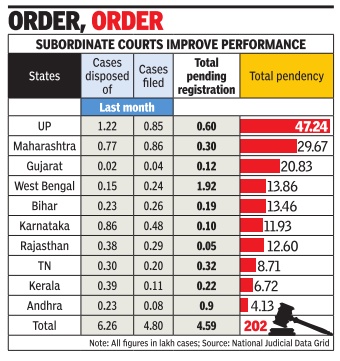
Pradeep Thakur
UP courts dispose of record 1.2L cases in Sept
The subordinate judiciary is showing some impressive results. The state with the reputation of being a laggard, Uttar Pradesh, has beaten courts in other states hands down in disposing of cases. The state with the highest number of pendency has disposed of more than 1.22 lakh cases last month alone. This was also probably one of UP's best performances given the fact that only 84,000 new cases were filed that month. Nationally , a little over 15,000 courts have disposed of 6.26 lakh cases last month as against 4.80 lakh new ones registered.
West Bengal remains among the worst performers with more than 1.92 lakh cases waiting to be registered and where courts have not yet provided a date to the litigants.Last month it disposed of around 15,000 cases as against 23,000 new cases filed.
In the case of UP, cases pending for registration is also much lower (60,000) than West Bengal which is a matter of concern for the Calcutta high court and also the state government which needs to aggressively push judicial reforms and expansion of courts in the state.
Information for subordinate courts in Delhi and Madhya Pradesh were not availa ble as the two states are yet to join the National Judicial Data Grid (NJDG).
As of now, the NJDG's public access page gives consolidated figures of pendency of cases in district judiciary across India. There is, however, no specific information on adjournments in each case, life cycle of a case before its disposal and whether first-cum-first-serve basis was applied in determining the trial of a case. Presently, the judicial data grid has information on only 2 crore pending cases as against pendency of more than 3.10 crore cases.
Like UP , the subordinate judiciary in Karnataka, Kerala, Tamil Nadu (TN), Rajasthan and Andhra Pradesh has shown better performance in terms of more disposal of cases than registered every month.While in Karnataka more than 86,000 cases were disposed of last month against 48,000 filed, in Kerala over 39,000 cases were disposed of against 11,000 filed.
In Andhra Pradesh, only 8,000 new cases were filed last month against 23,000 that were disposed of. The state has managed to bring down the total pendency of cases to almost 4 lakh though more than 90,000 cases were pending for registration, a parameter which indicates the state judiciary needs to introduce more transparency in court processes.
The government is also considering to get an independent study conducted on the data now available through the NJDG to find out the cause of huge pendency of cases.
2014: 3.07 crore cases pending, 2 crore over 5 years old
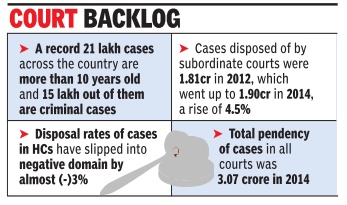
The Times of India, Oct 12 2015
28% of Rs 2cr pending cases over 5 yrs old
66% of prison population is of undertrials
The attempt to initiate transparency in justice delivery has failed to bring cheer to poor litigants. More than 28% of the 2 crore case pending in subordinate courts are over five years old, shows the latest statistics of the National Judicial Data Grid. It's not surprising that of the total pendency , a record 21 lakh cases across the country are more than 10 years old, and 15 lakh out of them are criminal cases where many undertrials remained behind bars even before their cases came up for trial.
The Supreme Court monitored e-courts project has brought in several changes in the justice delivery system. Most of the 15,000 courts in the country have been computerised and connected to the NJDG. A daily update on cases is reflected on the grid which is now open to public. Though the performance of 24 HCs are not reflected on the NJDG, in response to a Parliament question, law minister Sadananda Gowda had given out some statistics that showed a dismal performance. The disposal rates of cases in HCs have slipped into negative domain by almost (-)3% -from 17,86,170 cases disposed of in 2012 to 17,34,542 in 2014.
The performance of district and subordinate courts have been still better than the HCs. Cases disposed of by subordinate courts were 1,81,97,153 in 2012, which went up to 1,90,19,658 in 2014, an increase of 4.5%.
However, the better performances of apex court and the subordinate courts did not result in any major reduction in pendency . The total pendency of cases in all courts was 3.13 crore two years ago, which remained at 3.07 crore in 2014. The reduction was a little over six lakh cases during this period.
The conditions of undertrials have not improved either. Over 66% of the nearly 4 lakh prison population is of undertrials, a majority of them booked for petty offences and who cannot afford a lawyer and obtain a bail leading to years of incarceration.This despite the fact that the apex court had in a judgment on September 5 last year set a deadline of two months (by December 1, 2014) to release all undertrial prisoners who qualified as per its order.
Unique IDs to track work of 17,000 judges/ 2016
Pradeep Thakur, Unique IDs to track work of 17k judges, Nov 07 2016 : The Times of India
The government has issued unique identification numbers to 16,795 judges of district and subordinate courts across the country for better monitoring of their judicial functions. Supreme Court and high court judges have been exempted from the exercise.
As part of ongoing judicial reforms and modernisation of courts, digital signatures have also been provided to most judges in the district and subordinate judiciary so that they can sign orders while delivering the judgment, which can then be uploaded in real time. Judicial officers have been given laptops, printers and internet connections to facilitate the task.
Modernisation of courts is being carried out by the government as part of the eCourts project monitored by the apex court. The first phase of the project was completed in March 2015. The second phase is under way and will include giving unique IDs to the remaining 2,482 judges of district and subordinate courts and extending video-conferencing facilities to all courts.
TOI had reported on October 10 and 13 on the drive to allocate unique IDs to judges.The government had said the decision was part of a policy prepared under the guidance of the judge-in-charge of the eCommittee of the SC.
The idea behind giving unique IDs is to bring more transparency in judicial functions by making available all judgments delivered by a jud ge during hisher career on the publicly-accessible National Judicial Data Grid. The measure will help in effective tracking of judicial work.
The National Informatics Centre (NIC) is currently rolling out the upgraded software, the case information system (CIS) 2.0 version, for the eCourts project.
New additional fields in the system would make it mandatory for a judge to record the nature of daily proceedings, such as whether the hearing was for recording of witness statement, process evidence, arguments or if the case was adjourned.
Subordinate Judiciary vis-à-vis superior judiciary
Lower court judges pass resolution against HC rules
In an unprecedented move, Delhi’s subordinate judiciary has made public its opposition to stringent new rules laid down by the high court for purchase of laptops, computers, iPads, etc, by them. Last week, HC, for the first time, tightened rules for judges to buy “ technology devices” since 2014, when the entire Delhi judiciary was singed by allegations of irregularities in purchase of these items.
TOI had then highlighted how more than 300 lower court judges came under HC’s scanner for alleged financial irregularities in purchase of computers and laptops from funds provided by the Delhi government in 2013. As per the scheme, each judge is sanctioned Rs 1.10 lakh for upgrading their computer infrastructure where they have freedom to opt either for a computer, laptops or even iPads so that their efficiency in disposal of cases improves.
Keen to ensure that there was no repeat, HC brought in new clauses for the 2018-21 block period, triggering stiff opposition from subordinate judges, so much so that the Delhi Judicial Service Association (DJSA) — an organisation comprising judges — adopted a resolution on Wednesday against the new norms and apprised the HC of it.
“Till these unreasonable conditions are withdrawn, we appeal to all judges of Delhi District Judiciary not to purchase
any items to avail of the funds for the interest of Delhi Judiciary (sic),” the resolution says.
Sources claimed that the real bone of contention is one of the clauses asking every district court judge to attach a photograph/digital photograph of the purchased device showing the serial number, etc, for future verification by the HC administration, when receipts and invoices are filed for payment. DJSA has argued that the new circular specifying the rules is “unacceptable to us”, as it “further complicates the issue instead of simplifying it.”
“We are all senior gazetted officers, it is very demeaning that HC now wants us to provide photos of devices that we buy. It is with deep sense of hurt that we have passed the resolution,” a judge told TOI.
In the new rules, HC has banned cash/online purchases for those devices that cost more than Rs 5,000. “All such purchases should be made locally only through authorised dealers against invoices, bills,” one of the clause says, while another makes it clear that “the purchase should be made only in the name of judicial officers and not in the name of any family members or anyone”.
In 2014, the irregularities came to light during a routine vigilance inquiry conducted by court officials. When the evidence was shown to the then Chief Justice G Rohini and other senior judges, Justice Rohini set up a high-level panel of HC judges to examine how money was spent by each of these judges.
Trial courts
Appeals: HCs overturn 90% of trial court orders
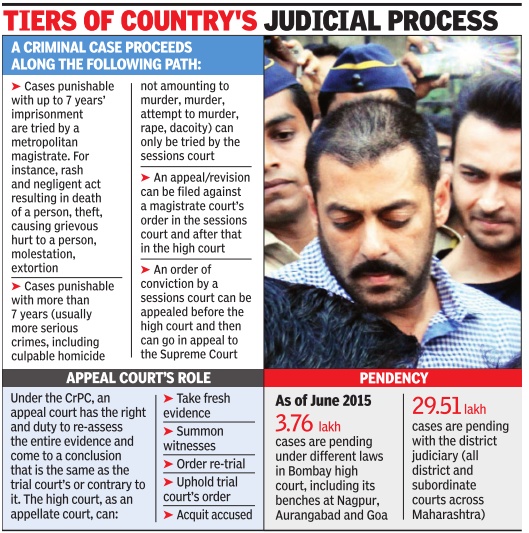
The Times of India, Dec 13 2015
Trial court orders are overturned by high court in 90% of cases: Lawyers
Swati Deshpande
`There's Nothing Singular About Salman Verdict' Actor Salman Khan, ac quitted by the HC of all charges in the 2002 Bandra hit-and-run case, is not an exception. He is among thousands of accused who are convicted by a lower court, only to be acquitted by a high court.HC orders often cite poor police investigation of a crime and faulty appreciation of evidence by the trial judge as reasons for setting aside guilty verdicts. While data on trial court convictions turning to acquittals is not compiled by the judiciary , a defence lawyer said that from 2013 till June 2015, out of 70 appeals in which he appeared in HC in Mumbai alone, he got acquittals in about 90% of the cases. Several lawyers cited such informal statistics. One of them said acquittals are not unusual in a HC-the last court on facts in a criminal case.
“Reasons given for the acquittals are mostly on the probability based on fact and circumstances of the case and on legal aspects that are usual on the point of appreciation of evidence by the lower court and thus admissibility of the evidence,“ said senior advocate Niteen Pradhan. “Most of the acquittals are due to the ineptness and inability of the police to perform their duty professionally , which is sometimes also a result of political interference.
“A glaring example was the Radhabai chawl incident, which sparked the 1993 riots.The Tada court had convicted over a dozen accused. But the SC in early 2000 acquitted all, disbelieving their confessions recorded by the police. The findings of the SC reflected poorly on police. Does it mean that no one had torched five persons to death? Drastic improvement in investigation by the police and reduction of political interference is needed.“
Legal experts compare the movement of a case from the trial court to the SC to a multilayered filtration process, where each court fulfils its responsibility; a trial court decision if overturned later by an appeal court can still get restored when the appeal court verdict is challenged before a superior court. The purpose of judicial hierarchy is to ensure that justice gets done, through checks and balances.Some feel that a decision by a subordinate criminal trial court is made sometimes with the knowledge that there are several layers ahead where there will be greater scrutiny.
Advocate Ayaz Khan, who appears in drug cases, said, “Sometimes there are cases where the trial court does not consider several factual aspects or even legal aspects slip their mind. Therefore the accused succeed in the HC.“ He agreed that a large number of cases end in acquittal. He appeared for a convict in a narcotics case which resulted in an acquittal before Justice A R Joshi late last month.
Another lawyer, Sujay Kantawalla, who appears in cases of customs-related offences, said that not all convictions end in acquittals. “Sessions court judges, despite lack of proper infrastructure, still pass reasoned orders. It's not that all convictions get over turned. But rarely does a trial court acquittal turn into a conviction in the HC.“ Reversal of acquittal or conviction is no mystery if one sees how `proof ' is defined in the Evidence Act.Veteran criminal lawyer Shrikant Bhat said, “Proof is the belief created in the mind of the trial court judge by evidence.Such belief is subjective.“
Bhat said, “Mainly , the HC reassesses the evidence and decides the correctness of the conclusions of the trial court.It may find that evidence of particular witnesses was not reliable or was reliable, and can decide whether witnesses accepted as experts by a trial court are indeed experts as required under the Evidence Act. The HC can see if the law is correctly applied. In murder cases, half the time the HC either acquits or reduces the offence to a lesser offence.“
Just as the HC changes or reverses the judgment of a trial court, the SC does likewise with HC judgments.
Can the actor's driver be tried?
Can Salman Khan's driver Ashok Singh, who confessed at the last stage of the trial that he was behind the wheel of the actor's SUV when the 2002 accident occurred, be tried? Most experts answer in the negative. There cannot be reinvestigation in a criminal case on issues that have already been investigated. The only exception was the postGodhra Best Bakery case, when the Supreme Court directed reinvestigation. “The order was exceptional and can't be used as a precedent. Investigation once completed, can't proceed on reinvented facts,“ said advocate Niteen Pradhan.
The HC order gives a certain finality to the Salman case and although the state can appeal against the acquittal, it can challenge it only to secure Salman's conviction based on re-interpretation of the existing evidence. The prosecution has always maintained that Salman was driving the car and trashed Singh's version as “unbelievable and put up“ in trial court when Singh deposed as a defence witness.Singh was neither an accused in the case nor a prosecution witness against the actor, and now lawyers agree that he is unlikely to be made an accused after so many years.
Salman Khan, a day after his acquittal, withdrew from the SC his plea to make singer Kamaal Khan a witness. The actor had sought to challenge a Bombay HC order earlier in December 2015 rejecting his plea to make his UK-based singer friend Kamaal a court witness during the hearing of his appeal against his May 2015 trial court conviction.
Trial courts, two-shift system
From the archives of The Times of India 2010
SC: Two-shift trial court system Two-shift a failure, won’t cut pendency
Dhananjay Mahapatra | TNN
New Delhi: Four years after hitting upon the simple yet effective idea of operating trial courts in two shifts to tackle the 3 crore pendency in subordinate judiciary, the Supreme Court on Tuesday appeared sceptical about the experiment. A bench comprising CJI K G Balakrishnan and Justices Deepak Verma and B S Chauhan said the idea was implemented to dispose of petty cases and not to hold regular trials during the morning and evening shifts.
“It will be a little too much to ask the trial judge to come in the morning and hear cases till late in the evening,” the bench said and suggested that the only way out was to increase the number of judges, whose strength at present was woefully inadequate to tackle the backlog. This stand assumes significance as PM Manmohan Singh had said on Saturday that the backlog and delay in disposal of cases had diminished the inherent strength of the judiciary.
Amicus curiae C S Vaidyanathan agreed with the bench and said, “An amount of Rs 2,500 crore is being provided to facilitate setting up of morning and evening courts in all the 14,825 district and subordinate courts in the country. This is an impractical and unfeasible proposal. Only petty criminal or compoundable cases were intended to be disposed of in such morning/ evening courts.”
Transparency
Lack of transparency in judicial functioning
The Times of India, Jun 28 2015
Pradeep Thakur
Give report on Backlog Panel, CJs told
Govt seeks update on HC pendency pickle
To bring accountability and transparency in the judiciary's functioning, law minister Sadananda Gowda has written to the chief justices of all 24 high courts and sought reports on the status of the arrears committee each of the HCs was to set up to bring down case pendency. In April 2015, at the chief justices conference, all the CJs had pledged to set up an arrears committee in each high court to dispose of cases pending for over five years in their respective HCs and the subordinate courts under them.
The NDA government had earlier taken up the matter with the Supreme Court, and the Chief Justice of India wrote to HC chief justices to deal with pendency .
Lack of transparency in judicial functioning has led to a higher pendency rate for older cases. There are plenty of instances, in fact, in some courts and under certain judges where adjournments have been the norm rather than exception.
As of December 2014, there were over 23 lakh cases pending for over five years in high courts alone. Add to this the pendency in subordinate courts, and the figure is staggering. The law minister had recently informed Parliament that the pendency in subordinate courts was a matter of concern, with over 82 lakh civil and 1.83 crore criminal cases pending.
Gowda has asked the CJs to submit a report detailing the steps taken towards reduction in pendency , and number of cases older than five years disposed of. He has also sought to know which of the HCs had set up the arrears committee.
Video recording of court proceedings
CCTV cameras in one court per state/ 2017
Dhananjay Mahapatra. Gurgaon court to have video-recorded trials, Feb 7, 2017: The Times of India
After rejecting several PILs seeking video recording of court proceedings, the Supreme Court finally appeared inclined to relent on Monday and said that as a first step, it would like installation of CCTV cameras in one district court in each state.
The experiment will be first carried out in the Gurgaon district court. Before passing the direction for installation of cameras in one court in each state to record proceedings, a bench of Justices Adarsh Kumar Goel and U U Lalit decided to send a twomember team -senior advocate R Venkataramani and additional solicitor general Maninder Singh -to the Gurga on district court to examine the working of CCTV cameras. It asked the two senior advocates on Monday to file a report on the feasibility of installing CCTV cameras for recording court proceedings. The Supreme Court has asked two senior advo cates to submit a report within four weeks on the feasibility of installing CCTV cameras for recording court proceedings. It asked the Gurgaon district judge to help the two lawyers make an on-the-spot study . The move is path-breaking, as the apex court had till now refused proposals for installation of cameras inside court rooms to record judicial proceedings in the three-tier justice dispensation system.
The decision came about in an innocuous matrimonial case where the husband had petitioned the apex court seeking a direction for “audio-video recording of proceedings by the trial court to ensure fair trial to the petitioner, may be at the cost of the petitioner“.
Justices Goel and Lalit recalled that the Centre had written to the SC in the past for video recording of court proceedings and also that the Law Commission had made a similar recommendation. The bench said it wanted to consider issuing directions for installation of CCTV cameras initially in one court in each state and take the matter forward on the basis of the result of this experiment.
ASG Singh said the ministry of law and justice was yet to file its response and it would be appropriate if the SC examined the issue after the ministry filed its affidavit. The bench agreed and sought a report on the Gurgaon court in four weeks and posted the matter for further hearing on March 21.
In March 2016, an online survey found that 97% of citizens wanted video recording of court hearings and were even willing to pay for recording of their cases. LocalCircles, a citizen engagement platform, conducted the survey , evoking responses from 13,000 persons -75% male and 25% female.“Over 80% of participants said they were willing to pay a retrieval fee for that video if it was a paid service,“ LocalCircles founder Sachin Taparia had told TOI.
2019/ TN judge puts CCTV in own chamber
In a first, TN judge puts CCTV in own chamber, February 15, 2019: The Times of India
Justice Subramaniam of Madras high court has become the first judge in India to voluntarily go under continuous CCTV glare in his own chamber after he himself “strongly” recommended that cameras be installed in the official chambers and office rooms of all higher officials in Tamil Nadu to avoid allegations of sexual harassment and safeguard the interest of women employees.
Quoting Mahatma Gandhi, who said, “An ounce of practice is worth more than tonnes of preaching,” Justice S M Subramaniam directed the court registry to install CCTV cameras in his own chamber to set an example.
“The police department is preaching with a responsibility that all the residents, apartment owners, traders and others shall install CCTV cameras in their respective premises, to enable police to nab offenders. This being the stand of the department, what about the offenders and black sheep in the chambers and office rooms of the department… What measures have been taken to nab them?” he asked. The judge made the observations while vacating the stay against a CB-CID probe into a sexual harassment complaint made by a woman superintendent of police against DVAC joint director S Murugan.
Pulling up the DVAC for not taking action on the complaint with due seriousness, the judge said, at the first instance, the Internal Complaints Committee was constituted under the chairmanship of A Radhika, deputy director, DVAC. It was a mockery on the part of the authorities concerned to appoint an officer in the rank of deputy director of DVAC as the presiding officer to conduct an enquiry against the joint director of the same department.
Technology
SMS, emails to litigants regarding next hearing, adjournments, summons…
SMS, emails bridge courts-litigants gap, December 9, 2017: The Times of India
40 Mails Sent To Lawyers, Litigants So Far
The judiciary is using technology to bridge the gap between courts and litigants with SMS and email messages directly being sent to litigants relating to next hearing on a case, adjournments, summons, etc. So far, nearly 40 lakh such mails have been sent to litigants and lawyers.
Like the railways, an SMS push service has also been started by the Union law ministry as part of the second phase of its eCourts project where litigants from rural areas without internet facility can send unique case no (CNR No) to 9766899899 and can obtain case status.
The automated mailing service was recently launched as part of the eCourts services. The government has allocated Rs 1,670 crore for implementation of phase two of the project which includes complete automation of workflow management in all courts. This comprises electronic movement of records from trial courts to appeal courts, installation of video conferencing facility and recording of witness through video conferencing and connecting all courts in the country to the National Judicial Data Grid.
The plan is also to provide citizen centric facilities such as electronic filing, e-payment and use of mobile applications, touchscreen based kiosks in each court complex and full computerisation of state and district level judicial and service academies and centres.
The mobile app launched for the services has already had three lakh downloads, Alok Srivastava, secretary, justice department in the law ministry, said at a meeting of the eCourts committee held last week. The eCourts committee of the Supreme Court is headed by Justice Madan B Lokur.
Srivastava said the specific targets set under the project include computerisation of all the 20,400 courts across the country; WAN and cloud connectivity in 3,500 court complexes; full Installation and use of video conferencing facility at 3,000 court complexes and 1,150 prisons; charting out key identified citizen services like electronic filing, daily orders, delivery of decrees, online case status in all the district courts, etc.
Women judges in judiciary
As in 2017
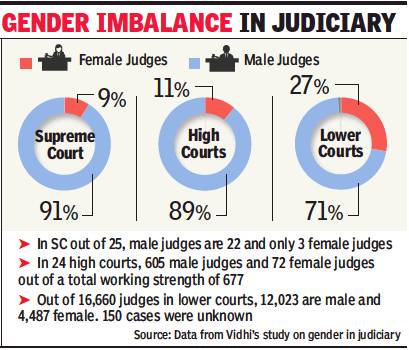
From: Pradeep Thakur, Just 27% of judges in lower courts women, reveals study, August 13, 2018: The Times of India
Marked Gender Bias In Selection Of Judges: AP Shah
Out of the 16,600 judges in district and subordinate courts across the country, less than 4,500 are women.
Legal think tank Vidhi Centre for Legal Policy released data which showed that out of 16,660 judges in lower courts, only 4,487 were women, or 27%. The figure was 11% in high courts and 9% in the SC, the think tank said.
Citing law ministry data, TOI had reported in January that Other Backward Classes comprised just 12% of judges in the lower judiciary.
Speaking at a conference on judicial diversity organised by Vidhi Centre, former Law Commission chairman Justice A P Shah said on Saturday that there was a “marked bias” when it came to choosing between a man and woman of equal merit for judgeship. Almost invariably, the man was selected, he added.
Justice Shah, who retired as chief justice of Delhi HC, said once he had recommended a woman advocate for elevation to HC judgeship but she was rejected for being “rude”. “Similar behaviour from a male counterpart would not have induced a similar judgment from selection body,” he said. “The discourse on judiciary today is dominated by questions of case pendency, backlog and delay. Representativeness of judiciary as an institution remains somewhere in background, surfacing when a ‘minority’ candidate’s name is suggested for appointment,” he said.
He said diversity as a policy issue had never received the attention it deserved from the higher judiciary, perhaps explained by the fact that in 68 years, the SC had only once elevated a woman from the bar, in January.
Vacancies in courts not filled; shortage of judges
SC on Malik Mazhar Sultan’s petition/ 2006
More than 12 years ago, from a petition by Malik Mazhar Sultan, the Supreme Court diagnosed a deep-rooted systemic problem that caused chronic shortage of judges in lower judiciary. Though the case pertained to Uttar Pradesh, the SC realised that the problem was common to all states.
In April 2006, a bench headed by then CJI Y K Sabharwal had said, “Non-filling of vacancies for long time not only results in avoidable litigation (like the one filed by Malik Mazhar Sultan) but also results in creeping of frustration in candidates. Further, non-filling of vacancies for long time deprives people of services of judicial offices.
“This is one of the reasons of huge pendency of cases in courts (which has remained at over 2.5 crore for the last 15 years). It is absolutely necessary to evolve a mechanism to speedily determine and fill vacancies of judges at all levels. For this purpose, timely steps are required to be taken for determination of vacancies, issue of advertisements, conducting examinations, interviews, declaration of final results and issue of orders of appointments.
“For all these and other steps, if any, it is necessary to provide for a fixed time schedule so that the system works automatically and there is no delay in filling up of vacancies.”
A year later, in Sanjay Singh vs UP Public Services Commission, the SC laid down details of how examinations for recruitment of trial judges were to be conducted, including settling of question papers and marking method to be adopted for evaluation of answer-sheets. The SC had hoped that the system, put under the supervision of high courts, would expeditiously fill vacancies which had been plaguing functioning of the base of justice delivery system.
By the time Justice Ranjan Gogoi took over as Chief Justice of India, the festering problem had left trial courts severely handicapped as nearly 25% posts of judicial officers were vacant. The functioning of trial judges was further impeded by woefully inadequate infrastructure and support staff.
If the HCs, appointed as supervisors to keep the system well-oiled, were casual in timely determination of vacancies and holding recruitment examinations through public services commissions, states were even more lethargic in providing infrastructure and support staff to trial judges citing fund crunch.
The SC felt that allowing the flailing system to continue any longer would amount to jeopardising the three-tier judicial structure’s foundation. At this critical juncture, the CJI-led bench stepped in to declare that “filling vacancies in subordinate judiciary is now the responsibility of the Supreme Court”.
While unveiling ‘Mission 2019’ for filling 5,000-odd trial judge vacancies, the CJI minced no words in declaring that it was his intention to fasten accountability on HCs for timely recruitment, and on states for providing adequate infrastructure — courtrooms, support staff and residences — for trial judges.
The initial results are encouraging. Uttar Pradesh, which has chronically been lethargic in recruiting trial judges and providing them with infrastructure, saw both Allahabad HC and Yogi Adityanath government agree to
meet the targets by September 2019. In the first phase of accountability fastening exercise, four other states too have fallen in line. If ‘Mission 2019’ succeeds, India for the first time will find its trial courts functioning at full strength.
That alone could make speedy justice a reality, which commoners have been yearning for and dreaming of since independence. The moral of this: it is important to devise a structured system to address problems caused by procedural lapses that get introduced by persons in charge of it. More importantly, there must be a super supervisor who must crack the whip once in a while to weed out human lethargy crippling the system itself.
The ‘MeToo’ campaign is a product of such systemic failure. The SC’s path-breaking judgment in Vishaka case in August 1997 and Parliament enacted Sexual Harassment of Women at Workplace (Prevention, Prohibition and Redressal) Act in 2013 provided detailed systems and procedures to make offices women-friendly. Yet, most offices have put in place an apology of a system for redressal of sexual harassment complaints by women employees.
For years, aggrieved women employees found the system unfriendly and approach of those manning the system towards complainants hostile. It was then that they took resort to extra-judicial methods and vent their humiliating experiences through social media to bring down sexual predators through naming and shaming. A few may have misused the ‘MeToo’ campaign and taken advantage to circulate slander, but the core of the problem still remains to be addressed — the hostility of the system towards entertaining and addressing complaints of sexual harassment.
The premier All India Institute of Medical Sciences presents a case in point. Four female students complained of sexual harassment against a department head and a faculty-in-charge. They alleged that they were asked “to take the relationship to another level” and “make a place in the hearts of the teacher” if they wanted to be taught about finer academic points.
The written complaint was of September 11, more than two months ago. AIIMS, whose doctors diagnose hidden deficiencies in a human system with ease, initially treated it as an academic complaint and set up an academic committee, in which the accused department head was a member. When the students howled at such a lapse, AIIMS quickly changed the composition of the committee. Two months later, AIIMS says it has constituted appropriate committees which will hear grievances of complainants individually.
When a system does not address grievances expeditiously and in a friendly manner, it often results in name and shame sniping process, which dents people’s faith in the system and scars the dignity of individuals.
1987: Judge-population ratio
The Times of India, Apr 17 2016
India has 17 judges for a million people
Pradeep Thakur
A 1987 report of the law commission had drawn a blueprint of the manpower required in the judiciary. At that time, the strength of the judiciary was 7,675 judges, or 10.5 judges per million people. The judge-population ratio (sanctioned strength) has since increased to 17 judges per million but the vacancies have surpassed the 5,000 mark and so have the backlogs.
The current sanctioned strength of the subordinate judiciary is 20,214 judges while that of the 24 high courts is 1,056 and the pendency of cases has remained abnormally high at 3.10 crore. On the sanctioned strength, there are 4,600 vacancies of judges in the subordinate judiciary which is more than 23% of the strength. The situation in the high courts is worse with almost 44% (462) judges' posts vacant. The Supreme Court too has six vacancies on a sanctioned strength of 31.
The appointments have been held up following a standoff between the apex court collegium and the government over the finalisation of the memorandum of procedure for selection of judges.
To address backlogs in justice delivery , the 120th report of the law panel had proposed to increase the strength to 50 judges per million people -less than the US where the judge-population ratio then was 107. In case of UK it was 51, for Canada it was 75 and Australia 42.
The 50 judges-per-million view was supported by the commission in its 245th report submitted to the government in 2014, an exercise carried out after three decades of the first manpower assessment without any substantial follow up action. The 20th law commission study found at the current rate of disposal, HCs require an additional 56 judges to break even and an additional 942 judges to clear the backlog. This estimation was based on the sanctioned strength of the HCs at 895.
“Bihar, for example, requires an additional 1,624 judges to clear backlog in three years,“ the 20th law panel observed. The problem of backlogs is compounded by the fact that in some states courts are unable to keep pace with new filings. As data shows, even where the courts are breaking even, the system is severely backlogged and requires urgent intervention.
Given the large number of judges required to clear pendency and the time to complete selection and training processes, the law commission recommended that the recruitment of new judges should focus, as a matter of priority , on the number of judges required to break even, and to dispose of the backlog in a three-year time frame.
Simplification of court procedures is another problem area. Different HCs have different procedures and rules. There is no uniformity , despite the fact that the government has repeatedly written to the chief justices to develop common court procedures.
Shortages of judges, courtrooms stifles justice delivery/ 1994-2014
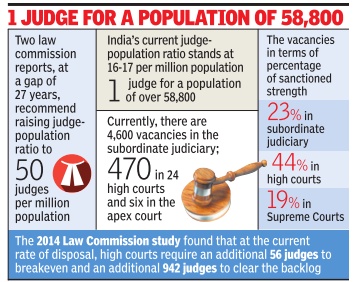
Pradeep.Thakur@timesgroup.com New Delhi:
The Times of India Jul 30 2014
Justice delivery has been hamstrung under successive governments for want of resources to provide enough courtrooms to accommodate the existing sanctioned strength of judges in high courts and subordinate judiciary .
An assessment by the law ministry in 2011 on funds requirement for infrastructure development in the subordinate courts had pegged it at Rs 7,346 crore for a period between 2011 and 2016. Against this, only Rs 2,200 crore has been released till March 2014.
The issue of lack of funds for new courts was recently raised by Chief Justice of India R M Lodha who sought additional allocation for the judiciary to fill up vacancies. There are at least 270 vacancies of judges across 24 high courts in the country. Situation is worse in the subordinate judiciary where there are more than 4,300 vacancies. The Narendra Modi government too has allocated a paltry Rs 1,100 crore in 201415 against the government's total plan expenditure of Rs 5.75 lakh crore. Out of the plan outlay of department of justice, only Rs 94 crore has been earmarked for justice delivery and Rs 936 crore for infrastructure development.
A review of existing infrastructure at some of the high courts revealed that even the projected new courtrooms in the next few years were not sufficient to accommodate the existing sanctioned strength in many of them.
2012-18: HC vacancies; 2018: vacancies increase to 40%
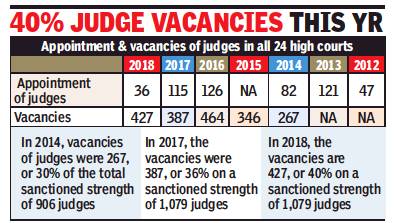
From: Pradeep Thakur, It may take 15 years to fill up judge vacancies in all HCs, September 16, 2018: The Times of India
Going by the current rate of appointments of judges in high courts, and considering that 75-85 judges retire on an average every year, it will take at least 15 years to fill up the existing 427 vacancies in all the 24 HCs.
Vacancies in HCs jumped to 40% on August 31 with 427 posts falling vacant and the working strength of judges coming down to 652 against a total approved posts of 1,079.
Despite the NDA government, on the recommendation of the higher judiciary, having appointed the highest number of HC judges in recent years, the rate of retirement means the effective addition has been only 29 judges each year overall.
Between April 2015 and May 2018, the law ministry notified appointments of 313 additional judges, among the highest in the last seven years, taking the average of judges appointed per year to 104. Yet, considering the number of judges retiring from HCs every year, the additions are modest though the situation would have been worse if the number of appointments had not been increased.
Vacancies a cause for concern as 40 lakh HC cases remain pending
During the UPA period, from 2012 to 2014, about 250 additional judges were appointed, an average of 83 each year.
The vacancies have been steadily rising. In October 2017, vacancies of judges in HCs stood at 387 and went up to 406 in March 2018 and 427 on August 31. In the next three years, on average, more than 65 permanent judges in the HCs are set to retire, not accounting for additional judges who are appointed initially for a two-year period and then considered for a permanent position.
The huge vacancies are a cause of concern for the government as well as the higher judiciary with 39.52 lakh cases pending in HCs, 22% of them for more than 10 years. A persistent difference of opinion between the SC and the government has stalled finalisation of a memorandum of procedure (MoP) for appointment of judges in the higher judiciary.
The revised MoP is supposed to streamline and expedite appointments and make the system more transparent and accountable. But the judiciary and government are at loggerheads over setting up formal mechanism for vetting candidates before recommending for elevation to SC or HCs.
The tiff continues. Recently, the government forwarded 126 recommendations from HC collegiums to the SC collegium with its own report, with background checks done by the Intelligence Bureau. The government found nearly half of the candidates unfit for judgeship of HCs. The government expressed reservations citing different issues in its comments on recommendations.
Sources said the government has set up a mechanism in the law ministry to evaluate each recommendation made by high court collegiums on the scale of merit and integrity, review of cited judgments, reputation as a lawyer in the legal fraternity — personal and professional — and his/ her minimum annual income.
Mandatory background checks by the IB also revealed issues of personal and professional integrity in some cases while “nepotism and favouritism” also cropped up as some of those recommended were close relatives of sitting and retired SC and HC judges.
HCs: 2015, Vacancies HCs
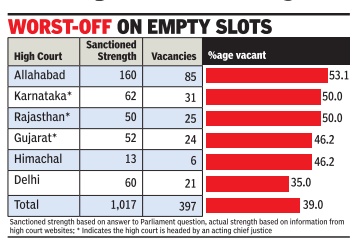
Shankar Raghuraman, Oct 18 2015: The Times of India
Shankar Raghuraman
HC vacancies hit 39% amid executive-judiciary face-off
The stand-off between the judiciary and the executive on how to appoint judges comes at a time when the country's 24 high courts have 397 vacancies for judges; what's more, eight HCs have acting chief justices. It is not clear at this point whether these vacancies can now be filled through the earlier collegium system or will have to wait till the system is improved as the Supreme Court has said it should be.
Data collated from HC websites shows that as of now, 397 of 1,017 posts of justices of high courts are vacant. That's a vacancy level of 39%, a serious shortfall when lakhs of cases are pending in the courts.
The biggest shortfall in absolute numbers and propor tion of sanctioned posts is in Allahabad where there are 75 judges against a sanctioned strength of 160.
50% Raj posts vacant, That means the num ber of vacancies, 85, is more than the number of sitting judges.
The Karnataka and Rajasthan high courts also have half the sanctioned posts lying vacant.
Another seven high courts have vacancy levels of over 40%. These include Gujarat, Andhra Pradesh and Madhya Pradesh. The Bombay high court with 33 vacancies, the Punjab & Haryana high court with the same number and the Madras high court with 23 vacancies are not significantly better off. These are among the biggest high courts in the country handling the largest workloads.Vacancies in them, therefore, have a serious impact on disposal of cases in the higher judiciary .
In fact, only three of the high courts are operating at full strength at the moment and these are the high courts of Sikkim, Meghalaya and Tripura. However, these are all much smaller high courts with sanctioned strengths of 3-4 judges.
The information collected from the websites also shows that the Bombay , Andhra Pradesh, Gujarat, Karnataka, Patna, Punjab & Haryana, Rajasthan and Gauhati high courts are all functioning with acting chief justices at the moment.
Will the confusion on what happens to appointments in the higher judiciary mean the situation not only continues to remain bad, but could actually worsen with some judges retiring? Don't bet against that.
HCs: Rift with government, unfilled vacancies/ 2015
The Times of India, Jun 01 2015
A subramani
33% of Madras HC judicial seats lying empty
It is a constitutional vacuum few are interested in resolving at the earliest, except, perhaps, the legal fraternity . At least 125 names, shortlisted and recommended by collegiums of various high courts in the country , for appointment as judges, are stuck even as the Centre is involved in a bitter legal battle with the higher judiciary over the National Judicial Appointments Commission's constitutionality, composition and powers.
As on date, no fresh appointments or even transfers of judges in higher judiciary are possible since the collegium system has been disbanded and the proposed NJAC is nowhere near reality . “For instance, onethird of the 60-member Madras high court is vacant and there is need for a few transfers as well. But though the court had forwarded nine names for appointment as judges more than four months ago, there has been no whisper from the Centre or SC,“ a top jurist told TOI.
The vacancy position in the HC plummeted below the one-third mark, with the retirement of senior judge Justice V Dhanapalan. In a fortnight another judge -Jus tice R S Ramanathan is set to retire. So, by mid-June, the court will have only 38 judges.Of them, Justice S Palanivelu, who has been ailing for more than a year now, is in no position to discharge his judicial work in a normal manner. Justice K B K Vasuki will retire in September, bringing the sitting strength to 37 by year-end.
“No exemptions or special approach to Madras high court is possible, as more than 100 names recommended for appointment as high court judges too are stuck,“ the jurist said.
Thanks to the revised norms wherein only the main cases are taken into account for both disposals and arrears, the Madras HC had 2.63 lakh pending cases on December 31, 2014.
Subordinate courts: 2015, almost ¼ posts vacant
Judicial vacancies in lower courts cross 5k, Oct 19 2016 : The Times of India
Delhi, Bihar And Gujarat Worst-Hit
It's not just the higher judiciary that is reeling under the pressure of huge vacancies and increasing burden of pendency of cases.A law ministry report says the situation in the subordinate courts is getting worse with the number of judges' posts vacant in the subordinate and district courts across the country crossing 5,000.
As of December 2015, the vacancies stand at 5,111 against a sanctioned strength of 21,303 judges in the subordinate judiciary. Gujarat, Bihar and Delhi rank among the states with the highest number of vacancies -about 40% to 44%.
In terms of numbers, the highest vacancy of judicial officers is in Gujarat at 794 against a sanctioned strength of 1,953, around 41% of its sanctioned strength. This is followed by Bihar with 792 against a sanctioned strength of 1,825, about 43% of its approved strength; UP has 595 posts to be filled, but they account for just 25% of its sanctioned strength of 2,394 judges. Lower courts in Delhi have 307 judges against a sanctioned strength of 793, which is around 39% of its approved strength.
Subordinate courts account for at least 2.30 crore of a total of about 3.15 crore pending cases across the country .UP alone accounts for 23% of these cases. In mid-2015, an estimation had put vacancies in lower courts at around 4,400.The rise in vacancies are a cause of concern for the Cent re since lower court judges are recruited through an examination conducted by state public service commissions or the respective high courts.
Even in the HCs, which have 464 judicial posts vacant against an approved strength of 1,079, the Centre merely plays the role of a post office, and in rare instances it refers back recommendations made by the Supreme Court collegium for reconsideration. To improve the efficiency of judges, the government is working closely with the SC in giving unique identification numbers to judges of the subordinate courts.
2015: Shortage of court staff in "lower" judiciary
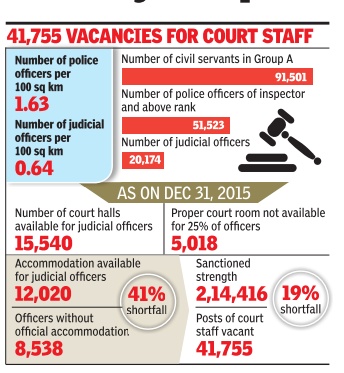
Underlining the severe shortage of judges in the lower judiciary , a Supreme Court report claimed there were 16 judges to address the needs of every million, whereas there were 42 police officers of the rank of inspector or above available for the same population. In terms of total strength, Group A civil servants across the country numbered 91,501, police officers 51,523, but the number of judges in the lower judiciary stood at just 20,174, according to data from 2015.
The report prepared by the apex court's Centre for Research and Planning, said judges' strength needed to be at least doubled in the next 10 years to handle the increasing number of cases being filed in lower courts. If this “crying“ need was not addressed, it warned the lower judiciary would be in danger of crumbling under the twin pressures of shortages of judicial officers and lack of proper infrastructure.
“The role of robust judiciary in a nation's development is pivotal. With development and a corresponding growth in litigation, more judges would certainly be required to handle the same so that justice is done in its truest possible sense,“ the report said and recommended that judges' strength be increased to 40,000-80,000 by 2040 to handle the rising number of cases awaiting adjudication.
Making a compelling case of how citizens' basic right of access to justice was being affected, the report compared the strength of police officers and bureau crats and concluded that the lower judiciary was the most understaffed organ of the state. It said proper infrastructure in terms of court rooms and residential accommodations for judges was not available, making it difficult to deliver timely justice to litigants.
“Based on the study and keeping in mind the future growth in institution of cases, it is found that the present judge strength is insufficient to deal with a huge figure of pendency of cases, which is a cause of concern,“ the report said.
2016: SC, High Courts/ sanctioned strength, vacancies
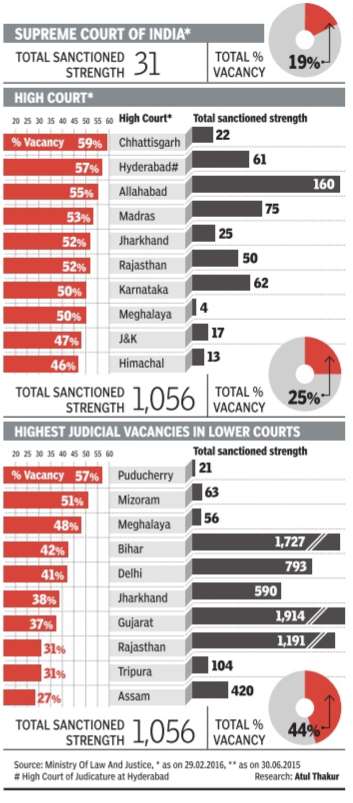
See graphic:
Total sanctioned strength and vacancies, the Supreme Court and the High Courts, 2016
2016: Govt. disagrees that 40,000 judges more needed
The Times of India, May 26 2016
Amit Anand Choudhary
Centre rejects CJI's claim of need for 40K more judges
The Centre virtually rejected Chief Justice of India T S Thakur's claim that 40,000 more judges were needed to obliterate over three crore pending cases by saying that his estimates were not backed by any scientific research or data.
Referring to 1987 Law Commission report suggesting increase in judges' strength, the CJI had on May 8 said the judiciary needed an additional 40,000 Judges to erase the mounting pendency . Law minister V Sadananda Gowda, however, said the Commission's report was based just on the opinion of experts.
“Law Commission's report of 1987 was based on opinion of experts and general public. No scientific data is available till now, therefore we cannot say much about it,“ he said.
At present, India has 10.5 judges per million, one of the lowest in the world. The Law Commission had in 1987 recommended that there should be 40 judges per million population. In 2014, the Commission in its 245th report suggested that it should be 50 judges per million.At present, total sanctioned strength of judges is 21,598, including 20,502 trial court judges, 1,065 HC judges and 31 Supreme Court judges.
Presenting the performance report of his ministry during the two years of NDA government, the minister re futed the allegation that the Centre was delaying the appointment process and said names of four persons for appointment as judges of the SC was cleared within six days. He said the Centre was processing names of 170 judges for appointment in HCs and it would soon be cleared.
“Judges' sanctioned strength in HCs has been increased from 906 on June 1, 2014 to 1065. In the case of subordinate courts, the sanctioned strength has been increased from 17,715 at the end of 2012 to 20,502,“ he said.
2016: 24 HCs have 43% vacancies
Pradeep Thakur, 24 HCs have a total of 43% judicial vacancies, Nov 02 2016 : The Times of India
The justice delivery system is taking a beating. Andhra leads with 62% vacancy among the 10 high courts with most number of vacant judicial posts.
The approved strength of the country's 24 high courts is 1,079, of which 464 posts or 43% are vacant.
According to the law ministry , 10 HCs account for 355 of the 464 vacant posts as of October 1. Allahabad HC leads with 83 vacant posts of judges, accounting for 52% of its approved strength. It is followed by Punjab & Haryana HC with 39 va cancies, or 46% of its sanctioned strength. The high court of judicature at Hyderabad, formerly the Andhra Pradesh HC, has 38 vacancies which is 62% of its sanctioned strength of 61, Karnataka HC has 36 posts vacant or 58% of its strength of 62 judges.
Between June 2014, when the NDA government assumed office, and now, the combined approved strength of the 24 HCs increased from 906 to 1,079. The increase in sanctioned judicial posts by 173 judges has primarily been responsible for an overall vacancy of 43%. The government claimed the working strength of judges in HCs remained more or less at the 615620 level during this period. In 2014, the 24 HCs had 267 vacant positions against an approved strength of 906. The vacancies accounted for less than 30%. In contrast, as a percentage of the sanctioned strength, the vacancies have gone up to 43% as of October 1.
2017: 23% posts vacant, SC guidelines not followed/ 2.5 crore cases pending
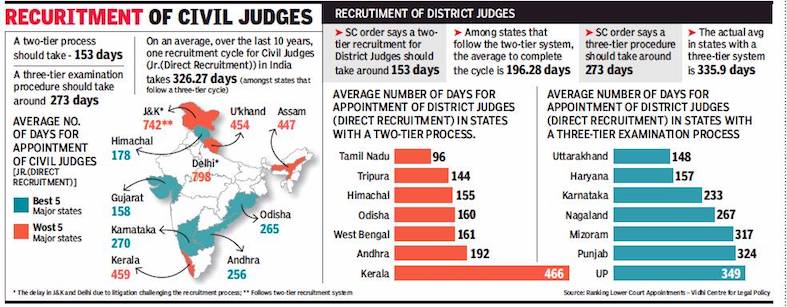
ii) Recruitment of district judges, state-wise
From: Radheyshyam Jadhav. SC’s timeframe for appointments in lower judiciary not being followed, December 5, 2017: The Times of India
See graphic:
i) Recruitment of civil judges;
ii) Recruitment of district judges, state-wise
23% Of Lower Judiciary Posts Vacant, 2.5 Crore Cases Pile Up
The Supreme Court said that judicial and legal services are missions for serving society and the mission is not achieved if the litigant has to wait in queue for a long time. Recognising that vacancies in the lower judiciary are an important reason for such long waits, it laid out timeframes for recruitments to these posts. Now, a study by New Delhi-based Vidhi Centre for Legal Policy has found that the SC timeframe is not followed in a majority of cases. The study also found that 2.5 crore cases are pending across the states as nearly 23% of posts in the lower judiciary, the first contact for a majority of litigants, remain vacant.
The average recruitment cycle, calculated for 18 states over 10 years, is 326.7 days for a three-tier recruitment process of civil judges (junior division). This is much longer than the SC-prescribed limit of 273 days.
States that follow a two-tier recruitment system take 196.3 days on average to complete one cycle to appoint district judges. Amongst states that follow a three-tier system, a complete recruitment cycle takes on average 335.9 days. Both figures exceed the SCprescribed limit of 153 days and 273 days, respectively.
The Vidhi Centre study comes against the backdrop of the Supreme Court initiating a suo motu public interest litigation, based on a letter from the law ministry to the SC secretary general in May this year. The letter proposed creating a central selection mechanism for the appointment of subordinate judges across the country.
The report observed “exams are not conducted frequently enough to fill vacancies as they arise and even when they are, high courts are often unable to find enough meritorious candidates”.
The Vidhi Centre has based its study on data (2007-2017) from recruitment-related notifications on the website of each high court and Public Service Commission, notifications announcing preliminary tests, main examinations, interviews and the final merit list.
Data from 20 states on appointment of civil judges (junior division-direct recruitment) reveal that Arunachal Pradesh, Odisha and Punjab were the top-ranking states while Jammu & Kashmir, Manipur and Delhi were ranked the lowest. The report ranked appointment processes for district judges (direct recruitment), relying on data from 15 states. Amongst them, Tamil Nadu and West Bengal were ranked the highest while Assam and Bihar were ranked the lowest.
In its order, the SC had said: “Speedy trial is a part of reasonable, fair and just procedure guaranteed under Article 21. This Constitutional right cannot be denied even on the plea of non-availability of financial resources. The court is entitled to issue directions to augment and strengthen investigating machinery, setting-up of new courts, building new court houses, providing more staff and equipment to the courts, appointment of additional judges and other measures as are necessary for speedy trial”.
2017: 26.4% posts vacant, 22.6 l Cases Pending 10 Years+
Pradeep Thakur, Vacancies in lower courts at all-time high, January 1, 2018: The Times of India
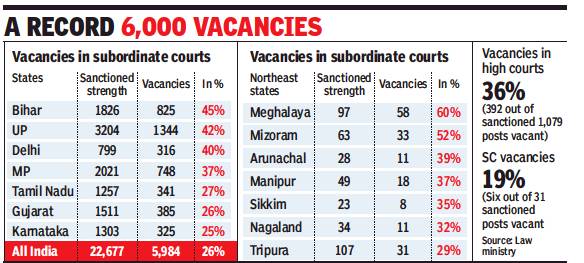
From: Pradeep Thakur, Vacancies in lower courts at all-time high, January 1, 2018: The Times of India
22.6 Lakh Cases Pending For Over 10 Years Now
Indecisiveness on adopting a common countrywidejudicial appointmentsexam for the subordinate judiciary has led to vacancies in lower courts, including district courts, touching an all-time high of almost6,000.
As on December 1, 5,984 judges’ posts were vacant in the subordinate judiciary against a sanctioned strength of 22,677 across the country. This does not include judges in the Supreme Court and high courts. There are currently only 16,693 judges in subordinate courts, one of the many reasons why lower courts have more than 2.61 crore pending cases, a top government sourcesaid.
The pendency in lower courts is a matter of concern with 22.57 lakh cases pending for more than 10 years, some as old as two or three decades. About 25% of cases in lower judiciary has been pending for over five years. More than 10% of these pending cases are filed by women and about 5% by senior citizens.
The all-India vacancy in subordinate judiciary is at 26% of the sanctioned strength, better than the HCs were vacancy is at 36% — about 392 judges’ posts are vacant in the 24 HCs against a sanctioned strength of 1,079. The SC has 19% vacancy with six of the 31 sanctioned posts vacant.
An analysis of state-wise vacancies in the lower judiciary showed that some states has 60% of judges’ positions vacant. Northeast states had the highest percentage of judges’ posts vacant. Meghalaya topped this list with 60% vacancy — against a sanctioned strength of 97, the state has 58 positions vacant. It was followed by Mizoram (52%), Arunachal Pradesh (39%), Manipur (37%), Sikkim (35%), Nagaland (32%) and Tripura (29%).
Among bigger states, Bihar toppedthelistwith45% vacancy in sanctioned strength of 1,826 judges. Uttar Pradesh has the highest number of sanctioned posts of 3,204 judges in thelower judiciary but 1,344, or 42%, of these positions were vacant. Delhi had 40% vacancies, followed by MP (37%), Tamil Nadu (27%), Gujarat (26%) and Karnataka (25%). Each of these states have anywhere between 300to1,300 posts vacant.
2018, May: Vacancies in HCs
Pradeep Thakur, Allahabad HC sends 15 more names for judgeship, May 5, 2018: The Times of India
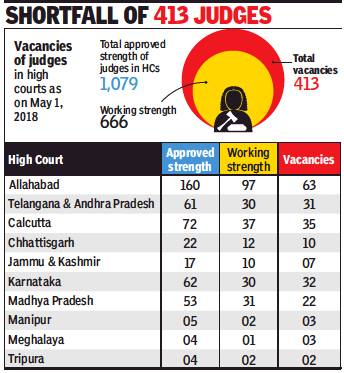
From: Pradeep Thakur, Allahabad HC sends 15 more names for judgeship, May 5, 2018: The Times of India
The Allahabad high court collegium has recommended 15 names of senior judicial officers for the appointment of HC judges, including seven district judges and five who are currently posted with the HC.
The names of 33 advocates, recommended by the HC collegium in February, is pending with the Supreme Court collegium as the government is verifying their background through the Intelligence Bureau (IB). The total number recommended for the HC has reached 48 which, if cleared, will bring the vacancies to an all-time low of 15 and take the bench strength to 90% of its sanctioned strength of 160 judges.
Sources said the 15 names include seven district judges of Lucknow, Bareilly, Mathura, Noida, Faizabad and Moradabad. Two judicial officers on the list are posted as principal secretaries, one as registrar general and one as member of the State Legal Services Authority. The names of 33 advocates recommended earlier by the HC collegium has been mired in controversy with several complaints reaching the law ministry and the PMO.
Of the 33 advocates, at least 11 are allegedly relatives and associates of sitting and retired judges of the SC and HC, including the brother-in-law of a sitting SC judge, a first cousin of another SC judge, besides sons and nephews of several present and former judges.
In 2016, the Allahabad HC collegium had recommended 30 advocates. After several complaints, then CJI T S Thakur had rejected the candidature of 11. The Centre had validated the allegations through background checks.
2018: the worst affected states
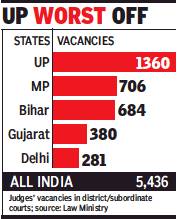
From: Pradeep Thakur, Govt plans exam to recruit 6k judges for lower courts, October 22, 2018: The Times of India
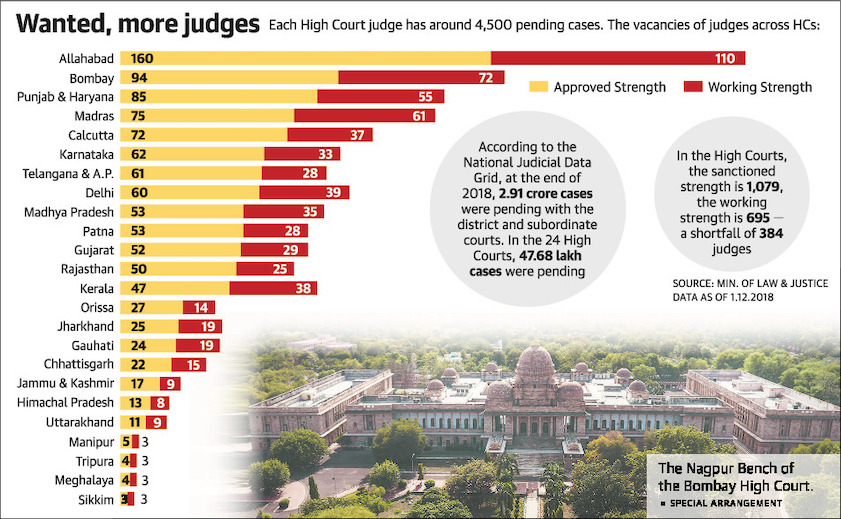
From: January 28, 2019: The Hindu
In what will wipe off the over 5,400 vacancies in judges’ posts in the lower judiciary, the Union law ministry is working with the Supreme Court to conduct a nationwide examination to recruit around 6,000 judges as a one-time measure.
The Union Public Service Commission (UPSC) or another central agency may be involved in conducting the test, separately for district judges and subordinate court judges, in states and Union Territories. Due importance will be given to local languages for those opting for a particular state, on the lines of NEET held by the CBSE for medical students. An all-India merit list will be prepared based on the proposed central selection mechanism.
Almost 3 crore cases pending in lower courts
The decision to hold the exam will be taken only after a directive is issued from the SC which is hearing a writ petition on the possibility of constituting an all-India judicial appointments mechanism, which was objected to by several states and high courts when the proposal was first mooted.
The initiative has got fresh impetus after CJI Ranjan Gogoi expressed his desire to fill up all judges’ posts immediately to bring down the huge pendency of cases in district and subordinate courts. Lower courts currently have pendency of 2.78 crore cases.
At present, all appointments of judges in district and subordinate courts are in the domain of state governments and high courts concerned. Inordinate delays in holding regular examination for recruitment of judicial officers for lower courts have led to huge vacancies. In April last year, the law ministry had urged the SC to create a central selection mechanism. The SC converted the Centre’s proposal into a writ petition on May 9, 2017, and directed all states and HCs to file their responses and suggestions.
Though not all states and HCs are on board on creation of the central mechanism, the CJI seems to have expressed willingness to go ahead with the as a one-time measure to fill up all vacancies and reduce pendency , sources said. The appointments will finally be made by the respective state governments based on the all-India merit list and HCs will have administrative control. The central selection mechanism is also intended to bring in uniformity in appointment of judicial officers across the country .
Women judges in the Supreme Court and High Courts
Please see Judiciary, superior: India
Women judges in subordinate courts
2017
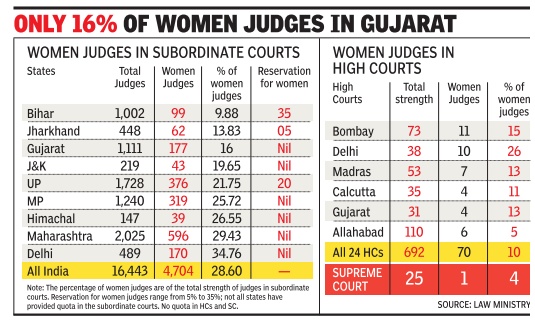
ii) Women judges in high courts, state-wise
From: Pradeep Thakur, Women account for less than 28% of total judges in country, October 30, 2017: The Times of India
Only 1 Among 25 Judges In SC Is A Woman
Women are breaking glass ceilings to become fighter pilots but the judiciary remains a male bastion with women comprising less than 28% of the current strength of 17,160 judges across all subordinate courts, high courts and the Supreme Court.
Information gathered by the law ministry paints a dismal picture on the number of women judges with subordinate courts accounting for 28% of the current strength of 16,443 judges. The large number of subordinate judicial officers raises the overall percentage which is lower in high courts.There are 4,704 women judges in the subordinate courts.
There is only one woman judge, Justice R Banumathi, in the current strength of 25 justices in the SC. No woman judge has been appointed in the apex court in the last three years since August 2014.
Interestingly, the lower judiciary of three north-east states buck the trend of low women representation. Meghalaya has a majority -26 judges or 63% of its total strength of 41, followed by Manipur where 14 of 25 judges are women, or 56% of the total. Sikkim has 46% women judges while Andhra and Telangana have 38%.
At least seven states have lower representation of women in the subordinate judiciary than the national average. Bihar, Jharkhand, Gujarat, Jammu & Kashmir, Uttar Pradesh, Madhya Pradesh and Himachal Pradesh have representation ranging from 10% to 25%.
Bihar has a low number of women judges despite 35% reservation, the highest in any state. The strength of women judges in Bihar's subordinate courts is below 10%, or 99 of its total strength of 1,002 judges.
There are quotas for women in lower courts in at least 11 states, ranging from 5% in Jharkhand to 35% in Bihar.Delhi, Maharashtra, West Bengal, Gujarat, Himachal, J&K, Kerala, MP , Punjab and Haryana have no quota for women in the judiciary , according to information gathered from HCs.
The number of women judges in HCs is also low -at just 70, they make up about 10% of its total current strength of 692 judges. At least nine HCs of Chhattisgarh, Gauhati, Himachal Pradesh, J&K, Jharkhand, Uttarakhand, Manipur, Meghalaya and Tripura do not have a single woman judge.
Delhi HC, headed by acting Chief Justice Gita Mittal, has 10 women judges out of a total strength of 38. Madras HC with seven women judges has the third highest representation. The country's largest high court of Allahabad has 110 judges and there are just six women.
See also
Supreme Court: India (mainly SC's rulings)
Supreme Court, India: Administrative issues
Supreme Court: India: Chief Justices
Supreme Court: India: Sitting judges
Judicial appointments, senior: India mainly the Collegium debate
Judiciary: India (powers, functions)
Judiciary: India
